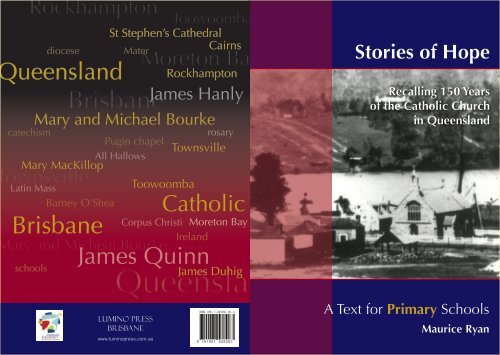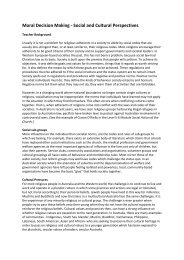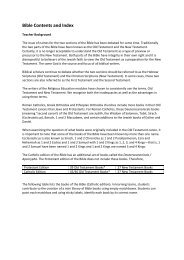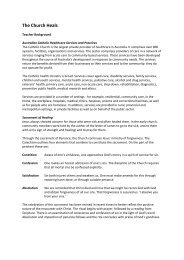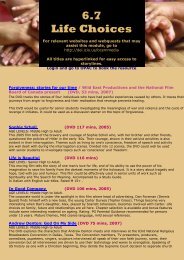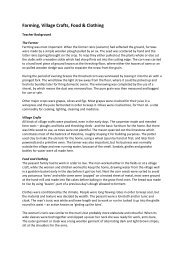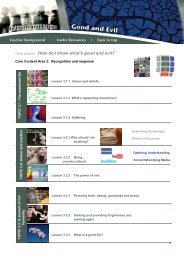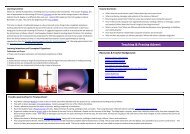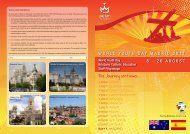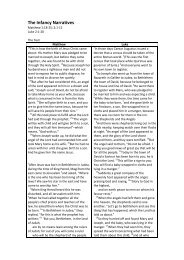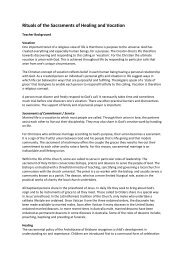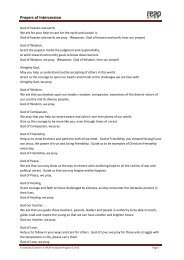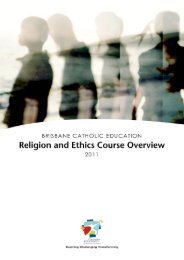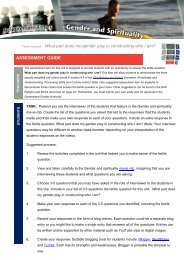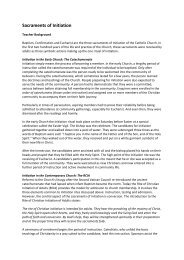Recalling 150 Years of the Catholic Church in Queensland
Recalling 150 Years of the Catholic Church in Queensland
Recalling 150 Years of the Catholic Church in Queensland
Create successful ePaper yourself
Turn your PDF publications into a flip-book with our unique Google optimized e-Paper software.
Rockhampton<br />
diocese Mater<br />
ueensland<br />
catechism<br />
St Stephen’s Ca<strong>the</strong>dral<br />
Cairns<br />
<strong>Queensland</strong><br />
Lum<strong>in</strong>o Press<br />
Brisbane<br />
www.lum<strong>in</strong>opress.com.au<br />
Moreton Bay<br />
Mary and Michael Bourke<br />
Mary MacKillop<br />
ownsville<br />
Lat<strong>in</strong> Mass<br />
Barney O’Shea<br />
Brisbane<br />
schools<br />
Brisbane<br />
Pug<strong>in</strong> chapel<br />
All Hallows<br />
Toowoomba<br />
ary and Micheal Bourke<br />
Rockhampton<br />
Townsville<br />
<strong>Catholic</strong><br />
Corpus Christi Moreton Bay<br />
Ireland<br />
James Qu<strong>in</strong>n<br />
Toowoomba<br />
James Hanly<br />
rosary<br />
James Duhig<br />
ISBN: 978 - 1 - 921538 - 06 - 3<br />
9 781921 538063<br />
HEAD<br />
Stories <strong>of</strong> Hope<br />
<strong>Recall<strong>in</strong>g</strong> <strong>150</strong> <strong>Years</strong><br />
<strong>of</strong> <strong>the</strong> <strong>Catholic</strong> <strong>Church</strong><br />
<strong>in</strong> <strong>Queensland</strong><br />
A Text for Primary Schools<br />
Maurice Ryan
Stories <strong>of</strong> Hope<br />
<strong>Recall<strong>in</strong>g</strong> <strong>150</strong> years <strong>of</strong> <strong>the</strong> <strong>Catholic</strong> <strong>Church</strong> <strong>in</strong><br />
<strong>Queensland</strong><br />
A Text for Primary Schools<br />
maurice Ryan<br />
lum<strong>in</strong>o press
is text was commissioned by <strong>Catholic</strong> Education <strong>in</strong><br />
<strong>the</strong> Archdiocese <strong>of</strong> Brisbane to commemorate <strong>the</strong> <strong>150</strong><br />
years celebrations <strong>of</strong> <strong>the</strong> <strong>Church</strong>.<br />
First published <strong>in</strong> Australia <strong>in</strong> 2009 by<br />
Lum<strong>in</strong>o Press<br />
PO Box 1024<br />
Hamilton QLD 4007<br />
publisher@lum<strong>in</strong>opress.com.au<br />
© <strong>Catholic</strong> Education<br />
Archdiocese <strong>of</strong> Brisbane 2009<br />
Imprimatur Most Rev JA Ba<strong>the</strong>rsby DD STD<br />
Nihil Obstat Rev Dr David Pascoe<br />
ISBN 978-1-921538-06-3<br />
Maurice Ryan, Stories <strong>of</strong> Hope: <strong>Recall<strong>in</strong>g</strong> <strong>150</strong> <strong>Years</strong> <strong>of</strong> <strong>the</strong><br />
<strong>Catholic</strong> <strong>Church</strong> <strong>in</strong> <strong>Queensland</strong><br />
Dr Maurice Ryan is a Senior Lecturer <strong>in</strong> <strong>the</strong> School<br />
<strong>of</strong> Religious Education, Australian <strong>Catholic</strong><br />
University, McAuley Campus <strong>in</strong> Brisbane.<br />
Typeset <strong>in</strong> Candara 12/16<br />
Cover design: Phoebe Brown<strong>in</strong>g<br />
Pr<strong>in</strong>ted by Worldwide Onl<strong>in</strong>e Pr<strong>in</strong>t<strong>in</strong>g - Hamilton, Qld<br />
An entry <strong>in</strong> <strong>the</strong> National Library <strong>of</strong> Australia<br />
catalogu<strong>in</strong>g-<strong>in</strong>-publication data is available for this title.<br />
The URLs given <strong>in</strong> this book were valid at <strong>the</strong> time<br />
<strong>of</strong> publication. However, some websites may have<br />
changed <strong>the</strong>ir content, <strong>the</strong>ir address, or may now l<strong>in</strong>k to<br />
o<strong>the</strong>r sites considered to be <strong>in</strong>appropriate. The author,<br />
publisher and rights holder regret any <strong>in</strong>convenience<br />
caused by <strong>the</strong> dynamic nature <strong>of</strong> <strong>the</strong> <strong>in</strong>ternet and urge<br />
care and vigilance when access<strong>in</strong>g <strong>the</strong>se web sites.<br />
This book is copyright. Apart from fair deal<strong>in</strong>g for<br />
<strong>the</strong> purpose <strong>of</strong> private study, research, criticism or<br />
review as permitted under <strong>the</strong> Copyright Act, no part<br />
may be reproduced, stored <strong>in</strong> a retrieval system or<br />
transmitted <strong>in</strong> any form by any person without prior<br />
written permission. Inquiries should be addressed to <strong>the</strong><br />
publisher at <strong>the</strong> address above. Permission for copy<strong>in</strong>g<br />
is granted on <strong>the</strong> condition that <strong>the</strong> relevant Copyright<br />
Agency Limited licens<strong>in</strong>g forms have been completed.<br />
For <strong>in</strong>formation on CAL, contact <strong>the</strong>m at:<br />
Copyright Agency Limited<br />
Level 15, 233 Castlereagh St<br />
Sydney, NSW 2000<br />
Tel (02) 9394 7600<br />
Fax (02) 9394 7601<br />
Email <strong>in</strong>fo@copyright.com.au<br />
Every effort has been made to trace and acknowledge<br />
copyright holders. The publisher welcomes an approach<br />
from anyone who believes <strong>the</strong>y own copyright to<br />
material <strong>in</strong> this book.<br />
ACKNOWLEDGEMENTS<br />
The follow<strong>in</strong>g people provided support to this project.<br />
Their assistance is gratefully acknowledged:<br />
Damien F Brennan, Director Religious Education and<br />
Curriculum Services, Brisbane <strong>Catholic</strong> Education.<br />
Mark Elliott, Pr<strong>in</strong>cipal Education Officer, Religious<br />
Education, Brisbane <strong>Catholic</strong> Education.<br />
The poem, “A Bush Christen<strong>in</strong>g” by A.B. (Banjo)<br />
Paterson, was first published <strong>in</strong> The Bullet<strong>in</strong> on 16<br />
December 1893. The extract from Steele Rudd, On Our<br />
Selection, was first published <strong>in</strong> 1899 by The Bullet<strong>in</strong>.<br />
The poem, Moreton Bay, is by an anonymous author<br />
whose orig<strong>in</strong>al publication is unknown.The photographs<br />
on pages 3, 4, 6 and 18 are from <strong>the</strong> State Library <strong>of</strong><br />
<strong>Queensland</strong> collection. The picture on page 26 is from<br />
<strong>the</strong> National Library <strong>of</strong> Australia collection.
<strong>Recall<strong>in</strong>g</strong> <strong>150</strong> <strong>Years</strong> <strong>of</strong> <strong>the</strong> <strong>Catholic</strong> <strong>Church</strong> <strong>in</strong> <strong>Queensland</strong><br />
The Beg<strong>in</strong>n<strong>in</strong>g <strong>of</strong> <strong>the</strong> <strong>Catholic</strong> <strong>Church</strong> <strong>in</strong> <strong>Queensland</strong><br />
The first <strong>Catholic</strong>s who came to <strong>Queensland</strong><br />
arrived on prison ships at Moreton Bay <strong>in</strong> 1824.<br />
They were convicts sent from o<strong>the</strong>r parts <strong>of</strong><br />
New South Wales. Moreton Bay was a place <strong>of</strong><br />
secondary punishment - if you were a convict<br />
transported to Australia and you broke <strong>the</strong> law<br />
after you arrived, <strong>the</strong> authorities sent you to<br />
Moreton Bay. It soon ga<strong>in</strong>ed a reputation for<br />
<strong>the</strong> cruel treatment <strong>of</strong> prisoners. They were<br />
<strong>of</strong>ten flogged with a whip, known as <strong>the</strong> cato-n<strong>in</strong>e-tails,<br />
made from n<strong>in</strong>e plaited ropes and<br />
commonly called <strong>the</strong> “cat”. It <strong>in</strong>flicted a terrify<strong>in</strong>g<br />
and pa<strong>in</strong>ful wound to <strong>the</strong> backs <strong>of</strong> convicts.<br />
1799 Capta<strong>in</strong> Mat<strong>the</strong>w Fl<strong>in</strong>ders<br />
explores Moreton Bay. Names<br />
Pumice Stone River and Red Cliff.<br />
Over half <strong>the</strong> men and women<br />
prisoners sent to Moreton Bay were orig<strong>in</strong>ally<br />
from Ireland. Most Irish people were <strong>Catholic</strong>s.<br />
Many <strong>of</strong> <strong>the</strong> guards who were sent to watch<br />
over <strong>the</strong> convicts were also orig<strong>in</strong>ally from<br />
Ireland. So, <strong>the</strong> majority <strong>of</strong> <strong>the</strong> orig<strong>in</strong>al<br />
permanent European settlers <strong>in</strong> <strong>Queensland</strong><br />
were <strong>Catholic</strong>s. But, <strong>the</strong>y came without priests<br />
or anyone much who could help <strong>the</strong>m with<br />
<strong>the</strong>ir religious needs.<br />
The song on <strong>the</strong> next page tells <strong>the</strong><br />
story <strong>of</strong> <strong>the</strong> wretched life <strong>of</strong> an Irish prisoner<br />
sent to Moreton Bay. The story takes place<br />
after <strong>the</strong> convict has heard about <strong>the</strong> death<br />
<strong>of</strong> <strong>the</strong> notorious Capta<strong>in</strong> Patrick Logan. Logan<br />
was commandant <strong>of</strong> <strong>the</strong> Moreton Bay prison.<br />
He was renowned for his harsh treatment <strong>of</strong><br />
<strong>the</strong> convicts. The song talks about him be<strong>in</strong>g<br />
killed by a local <strong>in</strong>digenous man. But, right up<br />
to <strong>the</strong> present day, people debate whe<strong>the</strong>r<br />
Logan was killed by <strong>in</strong>digenous men or by<br />
angry convicts.<br />
Can you name any landmarks <strong>in</strong><br />
<strong>Queensland</strong> that are named after Capta<strong>in</strong><br />
Patrick Logan? What do you th<strong>in</strong>k life might<br />
have been like for <strong>the</strong> first <strong>Queensland</strong><br />
<strong>Catholic</strong>s? What differences would <strong>the</strong>re be<br />
between Ireland and <strong>Queensland</strong>?<br />
The W<strong>in</strong>dmill on Wickham Terrace <strong>in</strong> Brisbane<br />
was built with stone and bricks by convicts<br />
<strong>in</strong> 1828 and is <strong>the</strong> oldest surviv<strong>in</strong>g build<strong>in</strong>g <strong>in</strong><br />
<strong>Queensland</strong>. It was used to gr<strong>in</strong>d flour and<br />
maize for <strong>the</strong> prison settlement. Convicts were<br />
assigned to an outside treadmill as punishment.<br />
1824 First convicts and soldiers at<br />
Redcliffe.<br />
1
Er<strong>in</strong>’s island is a<br />
name for Ireland.<br />
More than half <strong>the</strong><br />
prisoners sent to<br />
Moreton Bay were<br />
from Ireland. Most<br />
Irish people were<br />
<strong>Catholic</strong>s.<br />
The Moreton Bay<br />
triangle was a frame<br />
for hold<strong>in</strong>g prisoners<br />
while <strong>the</strong>y were be<strong>in</strong>g<br />
whipped with a cat-on<strong>in</strong>e-tails.<br />
F<strong>in</strong>d a picture<br />
<strong>of</strong> <strong>the</strong> “cat” on <strong>the</strong><br />
web.<br />
Logan was killed <strong>in</strong><br />
1830 while explor<strong>in</strong>g<br />
<strong>the</strong> upper reaches <strong>of</strong><br />
<strong>the</strong> Brisbane River.<br />
Local aborig<strong>in</strong>es were<br />
blamed though many<br />
thought <strong>the</strong> real<br />
culprits were convicts.<br />
See if you can f<strong>in</strong>d<br />
more about this<br />
mystery.<br />
2<br />
Moreton Bay<br />
One Sunday morn<strong>in</strong>g as I went walk<strong>in</strong>g<br />
By Brisbane waters I chanced to stray<br />
I heard a convict his fate bewail<strong>in</strong>g<br />
As on <strong>the</strong> sunny river bank he lay<br />
I am a native from Er<strong>in</strong>’s island<br />
But banished now from my native shore<br />
They stole me from my aged parents<br />
And from <strong>the</strong> maiden I do adore<br />
I’ve been a prisoner at Port Macquarie<br />
At Norfolk Island and Emu Pla<strong>in</strong>s<br />
At Castle Hill and at cursed Toongabbie<br />
At all <strong>the</strong>se settlements I’ve been <strong>in</strong> cha<strong>in</strong>s<br />
But <strong>of</strong> all places <strong>of</strong> condemnation<br />
And penal stations <strong>in</strong> New South Wales<br />
To Moreton Bay I have found no equal<br />
Excessive tyranny each day prevails<br />
For three long years I was beastly treated<br />
And heavy irons on my legs I wore<br />
My back from flogg<strong>in</strong>g was lacerated<br />
And <strong>of</strong>t times pa<strong>in</strong>ted with my crimson gore<br />
And many a man from downright starvation<br />
Lies moulder<strong>in</strong>g now underneath <strong>the</strong> clay<br />
And Capta<strong>in</strong> Logan he had us mangled<br />
All at <strong>the</strong> triangles <strong>of</strong> Moreton Bay<br />
Like <strong>the</strong> Egyptians and ancient Hebrews<br />
We were oppressed under Logan’s yoke<br />
Till a native black ly<strong>in</strong>g <strong>the</strong>re <strong>in</strong> ambush<br />
Did deal this tyrant his mortal stroke<br />
My fellow prisoners be exhilarated<br />
That all such monsters such a death may f<strong>in</strong>d<br />
And when from bondage we are liberated<br />
Our former suffer<strong>in</strong>gs will fade from m<strong>in</strong>d<br />
Moreton Bay was a<br />
place <strong>of</strong> secondary<br />
punishment. Unruly<br />
convicts from o<strong>the</strong>r<br />
parts <strong>of</strong> New South<br />
Wales were sent <strong>the</strong>re.<br />
F<strong>in</strong>d on a map <strong>the</strong> o<strong>the</strong>r<br />
places mentioned here.<br />
Patrick Logan became<br />
Commandant <strong>of</strong> <strong>the</strong><br />
Moreton Bay prison<br />
settlement <strong>in</strong> 1826.<br />
He was hated by <strong>the</strong><br />
convicts for his harsh<br />
punishments.<br />
From February to<br />
October <strong>in</strong> 1828 Logan<br />
ordered 200 prisoners<br />
to be flogged with over<br />
11,000 lashes <strong>of</strong> <strong>the</strong><br />
“cat”.<br />
Listen to a version <strong>of</strong> this song at http://users.bigpond.net.au/aussieconnection/moretonbay.html Your<br />
class can learn this song and perform it for an audience.<br />
1825 New site for <strong>the</strong> Moreton<br />
Bay prison at meanj<strong>in</strong>, later called<br />
Brisbane.<br />
STORIES OF HOPE<br />
1827 Botanist Alan Cunn<strong>in</strong>gham<br />
f<strong>in</strong>ds a gap through <strong>the</strong> Divid<strong>in</strong>g<br />
Range to <strong>the</strong> Darl<strong>in</strong>g Downs.
<strong>Recall<strong>in</strong>g</strong> <strong>150</strong> <strong>Years</strong> <strong>of</strong> <strong>the</strong> <strong>Catholic</strong> <strong>Church</strong> <strong>in</strong> <strong>Queensland</strong><br />
The picture on this page is one <strong>of</strong> <strong>the</strong> oldest<br />
<strong>of</strong> Brisbane we have. It shows Brisbane <strong>in</strong><br />
<strong>the</strong> year 1862, three years after <strong>the</strong> colony <strong>of</strong><br />
<strong>Queensland</strong> separated from New South Wales.<br />
It is also three years after <strong>the</strong> <strong>Catholic</strong> <strong>Church</strong><br />
<strong>in</strong> <strong>Queensland</strong> was <strong>of</strong>ficially established.<br />
The picture is taken look<strong>in</strong>g across to<br />
Kangaroo Po<strong>in</strong>t. In <strong>the</strong> middle <strong>of</strong> <strong>the</strong> picture is<br />
St Stephen’s <strong>Catholic</strong> Ca<strong>the</strong>dral. At <strong>the</strong> time, it<br />
was one <strong>of</strong> <strong>the</strong> grandest build<strong>in</strong>gs <strong>in</strong> <strong>the</strong> new<br />
settlement. People who sailed up <strong>the</strong> Brisbane<br />
River would be greeted by a view <strong>of</strong> <strong>the</strong> stone<br />
build<strong>in</strong>g stand<strong>in</strong>g prom<strong>in</strong>ently <strong>in</strong> <strong>the</strong> middle <strong>of</strong><br />
<strong>the</strong> young town. Today, <strong>the</strong> build<strong>in</strong>g is called<br />
1840 Brisbane opens to free settlers.<br />
Mak<strong>in</strong>g a <strong>Church</strong> <strong>in</strong> <strong>Queensland</strong><br />
St Stephen’s Chapel and <strong>the</strong> Pug<strong>in</strong> Chapel (<strong>in</strong><br />
honour <strong>of</strong> <strong>the</strong> architect who designed it). It<br />
stands right beside <strong>the</strong> new Ca<strong>the</strong>dral that was<br />
begun <strong>the</strong> year after this picture was taken.<br />
The build<strong>in</strong>g <strong>in</strong> <strong>the</strong> foreground across<br />
from <strong>the</strong> Ca<strong>the</strong>dral was demolished n<strong>in</strong>e<br />
years after this photo. It was built <strong>in</strong> 1829 as a<br />
convict women’s factory. It later was used as a<br />
court house and <strong>the</strong>n a fire station.<br />
Look at this photograph. What do you<br />
notice? What do you th<strong>in</strong>k life would be like for<br />
<strong>the</strong> <strong>Catholic</strong>s <strong>of</strong> Brisbane who worshipped at<br />
this Ca<strong>the</strong>dral? What changes would you see if<br />
you took a photo <strong>of</strong> <strong>the</strong> same area today?<br />
1843 (May) Sydney Archbishop<br />
John Bede Pold<strong>in</strong>g arrives <strong>in</strong><br />
Brisbane.<br />
3
In December 1843, Fa<strong>the</strong>r James Hanly<br />
disembarked from <strong>the</strong> James Watt <strong>in</strong> Brisbane.<br />
He was <strong>the</strong> first priest to be permanently<br />
stationed <strong>in</strong> <strong>the</strong> new settlement <strong>of</strong> Brisbane.<br />
He was young and energetic and he loved<br />
horses. He had a parcel <strong>of</strong> land called<br />
Castleracket on Boundary Street <strong>in</strong> Fortitude<br />
Valley where he fed and exercised “quite an<br />
unusual number” <strong>of</strong> horses, accord<strong>in</strong>g to one<br />
<strong>of</strong> his parishioners. Fa<strong>the</strong>r Hanly’s Castleracket<br />
farm would later become <strong>the</strong> site <strong>of</strong> St James<br />
Boys College.<br />
Fa<strong>the</strong>r Hanly needed horses to help him<br />
travel around his large “parish”. He travelled<br />
widely, visit<strong>in</strong>g <strong>Catholic</strong>s <strong>in</strong> <strong>the</strong> outly<strong>in</strong>g<br />
districts. Sometimes his arrival <strong>in</strong> a new place<br />
could cause confusion: some people had never<br />
seen a priest before! In 1844 he undertook a<br />
long journey through <strong>the</strong> Darl<strong>in</strong>g Downs and<br />
nor<strong>the</strong>rn New England districts. Accord<strong>in</strong>g to<br />
1843 (December) First priests<br />
arrive <strong>in</strong> Brisbane. Fr James Hanly<br />
rema<strong>in</strong>ed <strong>in</strong> Brisbane until 1857.<br />
4<br />
Fa<strong>the</strong>r Hanly’s Horses<br />
STORIES OF HOPE<br />
one observer, his arrival on horseback at Ben<br />
Lomond Station “dressed <strong>in</strong> black with a tall<br />
black hat caused genu<strong>in</strong>e alarm among local<br />
Aborig<strong>in</strong>es. Yet after <strong>the</strong>ir <strong>in</strong>itial dismay, <strong>the</strong><br />
Aborig<strong>in</strong>es and Fr Hanly became friends”.<br />
Like many priests <strong>in</strong> <strong>the</strong> early days <strong>of</strong><br />
<strong>the</strong> <strong>Catholic</strong> <strong>Church</strong> <strong>in</strong> <strong>Queensland</strong>, Fa<strong>the</strong>r<br />
Hanly relied on his horses. People <strong>in</strong> <strong>the</strong> rural<br />
areas he visited were <strong>in</strong>cl<strong>in</strong>ed to judge a man’s<br />
value as a priest by his skills <strong>in</strong> handl<strong>in</strong>g a<br />
horse. A priest on horseback travell<strong>in</strong>g <strong>in</strong> <strong>the</strong><br />
outly<strong>in</strong>g regions shared <strong>the</strong> same setbacks<br />
as people <strong>in</strong> <strong>the</strong> bush - gett<strong>in</strong>g lost, horses<br />
made lame by <strong>the</strong> hard ground, hot summers<br />
and wet w<strong>in</strong>ters. One day Fa<strong>the</strong>r Hanly<br />
could be found baptis<strong>in</strong>g a child on a Darl<strong>in</strong>g<br />
Downs station; <strong>the</strong> next week would see him<br />
comfort<strong>in</strong>g a condemned Irish-<strong>Catholic</strong> convict<br />
about to be hanged on <strong>the</strong> scaffolds <strong>of</strong> <strong>the</strong><br />
Moreton Bay prison.<br />
Imag<strong>in</strong>e you are Fa<strong>the</strong>r<br />
Hanly rid<strong>in</strong>g your horses<br />
to <strong>the</strong> country districts<br />
to visit <strong>the</strong> <strong>Catholic</strong>s who<br />
live <strong>in</strong> country towns<br />
and stations. How long<br />
would it take to ride from<br />
Brisbane to Stanthorpe?<br />
What would you take<br />
with you? Where would<br />
you stay along <strong>the</strong> way?<br />
What would you see?<br />
Who would you meet?<br />
1844 Ludwig Leichhardt and<br />
Thomas Mitchell beg<strong>in</strong> <strong>the</strong>ir<br />
explorations <strong>of</strong> <strong>Queensland</strong>.
<strong>Recall<strong>in</strong>g</strong> <strong>150</strong> <strong>Years</strong> <strong>of</strong> <strong>the</strong> <strong>Catholic</strong> <strong>Church</strong> <strong>in</strong> <strong>Queensland</strong><br />
1845 First <strong>Catholic</strong> school <strong>in</strong> Brisbane beg<strong>in</strong>s.<br />
It is run by Michael and Mary Bourke <strong>in</strong><br />
Elizabeth St, now <strong>the</strong> site <strong>of</strong> <strong>the</strong> Myer Centre.<br />
Bishop Qu<strong>in</strong>n Arrives <strong>in</strong> Brisbane<br />
Bishop James Qu<strong>in</strong>n was <strong>the</strong> first bishop<br />
appo<strong>in</strong>ted to <strong>the</strong> new Diocese <strong>of</strong> Brisbane. He<br />
was born <strong>in</strong> Ireland. Before com<strong>in</strong>g to Brisbane<br />
he was <strong>the</strong> pr<strong>in</strong>cipal <strong>of</strong> a school <strong>in</strong> Ireland for<br />
boys who were tra<strong>in</strong><strong>in</strong>g to become priests. In<br />
1861 he arrived <strong>in</strong> Brisbane by boat. With him<br />
were six Sisters <strong>of</strong> Mercy from Ireland who<br />
had come to open schools and care for <strong>the</strong><br />
<strong>Catholic</strong> families <strong>of</strong> <strong>Queensland</strong>.<br />
Bishop Qu<strong>in</strong>n’s first impressions <strong>of</strong><br />
Brisbane were not positive. He is supposed to<br />
have said: “Where is <strong>the</strong> city <strong>of</strong> Brisbane?” when<br />
he saw <strong>the</strong> place for <strong>the</strong> first time. He cannot<br />
have been impressed when he saw a bullock<br />
team bogged <strong>in</strong> <strong>the</strong> mud <strong>of</strong> <strong>the</strong> ma<strong>in</strong> street <strong>of</strong><br />
Brisbane, Queen Street. We can imag<strong>in</strong>e that<br />
<strong>the</strong> grimy streets and split-bark huts did not<br />
compare well with <strong>the</strong> f<strong>in</strong>e European streets<br />
and build<strong>in</strong>gs he had left beh<strong>in</strong>d forever to<br />
make his new home <strong>in</strong> Brisbane.<br />
Gett<strong>in</strong>g Down to Work<br />
Bishop Qu<strong>in</strong>n set to work lead<strong>in</strong>g <strong>the</strong> <strong>Catholic</strong><br />
<strong>Church</strong> <strong>in</strong> a diocese that covered <strong>the</strong> whole<br />
<strong>Queensland</strong>. What a large area it was.<br />
<strong>Queensland</strong> was <strong>the</strong> same size as France, Italy<br />
and Spa<strong>in</strong> toge<strong>the</strong>r. These countries toge<strong>the</strong>r<br />
had dozens <strong>of</strong> <strong>Catholic</strong> bishops to lead <strong>the</strong><br />
church; <strong>Queensland</strong> had one.<br />
When he arrived, Brisbane was <strong>the</strong><br />
poorest <strong>Catholic</strong> diocese <strong>in</strong> all <strong>the</strong> Australian<br />
colonies. Qu<strong>in</strong>n encouraged Irish <strong>Catholic</strong>s<br />
to migrate to <strong>Queensland</strong>, br<strong>in</strong>g<strong>in</strong>g families,<br />
employment skills, and a will<strong>in</strong>gness to work<br />
hard <strong>in</strong> a land full <strong>of</strong> opportunities.<br />
Qu<strong>in</strong>n <strong>in</strong>vited teachers from religious<br />
orders to come to Brisbane to set up schools.<br />
In those days, most <strong>Catholic</strong> schools were run<br />
by lay <strong>Catholic</strong>s, usually women or married<br />
couples. Bishop Qu<strong>in</strong>n encouraged local<br />
communities to raise money and build parish<br />
churches. He reached out to <strong>the</strong> leaders <strong>of</strong><br />
o<strong>the</strong>r Christian communities. This was unusual<br />
<strong>in</strong> a time when different Christian communities<br />
- especially those <strong>in</strong> Europe - did not always get<br />
Bishop James Qu<strong>in</strong>n, <strong>the</strong> first <strong>Catholic</strong><br />
bishop <strong>of</strong> <strong>Queensland</strong>.<br />
1850 The first <strong>Catholic</strong> chapel, St<br />
Stephen’s, built <strong>in</strong> Brisbane town.<br />
5
along toge<strong>the</strong>r very well. But <strong>in</strong> <strong>Queensland</strong>,<br />
th<strong>in</strong>gs were a little better.<br />
Bishop Qu<strong>in</strong>n was energetic and<br />
worked tirelessly for <strong>the</strong> development <strong>of</strong> <strong>the</strong><br />
<strong>Catholic</strong> <strong>Church</strong> <strong>in</strong> <strong>Queensland</strong>. He also found<br />
himself <strong>in</strong> arguments with o<strong>the</strong>r members <strong>of</strong><br />
<strong>the</strong> <strong>Catholic</strong> <strong>Church</strong>. He was strong willed and<br />
had def<strong>in</strong>ite op<strong>in</strong>ions about <strong>the</strong> best ways<br />
forward <strong>in</strong> develop<strong>in</strong>g <strong>the</strong> <strong>Queensland</strong> <strong>Church</strong>.<br />
He also <strong>of</strong>ten found himself <strong>in</strong> disputes with<br />
government <strong>of</strong>ficials. Despite this, Bishop<br />
Qu<strong>in</strong>n is remembered as a strong leader who<br />
provided a solid foundation for <strong>the</strong> <strong>Catholic</strong><br />
<strong>Church</strong> <strong>in</strong> <strong>Queensland</strong>.<br />
A <strong>Church</strong> on <strong>the</strong> Hill<br />
We can th<strong>in</strong>k <strong>of</strong> Bishop James Qu<strong>in</strong>n<br />
as someone who set a pattern for <strong>the</strong><br />
development <strong>of</strong> <strong>the</strong> <strong>Catholic</strong> <strong>Church</strong> <strong>in</strong><br />
<strong>Queensland</strong>. Qu<strong>in</strong>n thought that every<br />
<strong>Queensland</strong> settlement should have a<br />
collection <strong>of</strong> <strong>Catholic</strong> build<strong>in</strong>gs - a church, a<br />
presbytery for <strong>the</strong> priest, a convent for <strong>the</strong><br />
nuns, and a <strong>Catholic</strong> school all surrounded<br />
ACTIVITY Design a Postage Stamp<br />
Design a postage stamp us<strong>in</strong>g a person or<br />
event from <strong>the</strong> history <strong>of</strong> <strong>the</strong> <strong>Catholic</strong> <strong>Church</strong><br />
<strong>in</strong> <strong>Queensland</strong> as <strong>the</strong> <strong>the</strong>me for <strong>the</strong> design.<br />
Go to <strong>the</strong> AustraliaPost website www.<br />
auspost.com.au to view <strong>the</strong> current range<br />
<strong>of</strong> postage stamps. This site also conta<strong>in</strong>s a<br />
page <strong>in</strong>form<strong>in</strong>g designers <strong>of</strong> AustraliaPost’s<br />
requirements for stamp design. The website<br />
<strong>in</strong>vites designers to submit <strong>the</strong>ir ideas for<br />
consideration as future issues <strong>of</strong> Australian<br />
stamps.<br />
1859 Colony <strong>of</strong> <strong>Queensland</strong> constituted<br />
on June 6. First <strong>Catholic</strong> bishop <strong>of</strong> Brisbane,<br />
James Qu<strong>in</strong>n consecrated June 29.<br />
6<br />
by <strong>the</strong> houses <strong>of</strong> <strong>Catholic</strong>s. And, wherever<br />
possible, all built on a hill!<br />
You might th<strong>in</strong>k about <strong>the</strong> <strong>Catholic</strong><br />
community <strong>in</strong> your own local area, especially<br />
if it has been <strong>the</strong>re for a long time, and see if<br />
it matches this pattern set by Bishop Qu<strong>in</strong>n.<br />
What build<strong>in</strong>gs belong to <strong>the</strong> <strong>Catholic</strong> <strong>Church</strong>?<br />
Are <strong>the</strong> ma<strong>in</strong> <strong>Catholic</strong> build<strong>in</strong>gs on a hill? How<br />
long have <strong>the</strong>se build<strong>in</strong>gs been <strong>the</strong>re?<br />
O<strong>the</strong>r bishops, especially, Archbishop<br />
James Duhig would cont<strong>in</strong>ue this pattern<br />
<strong>of</strong> <strong>Catholic</strong> parishes established on <strong>the</strong> hills<br />
<strong>of</strong> <strong>Queensland</strong>. Duhig was appo<strong>in</strong>ted to be<br />
<strong>the</strong> Bishop <strong>of</strong> <strong>the</strong> Rockhampton diocese <strong>in</strong><br />
1905. He was one <strong>of</strong> <strong>the</strong> youngest <strong>Catholic</strong><br />
bishops <strong>in</strong> <strong>the</strong> world at that time. In 1917 he<br />
became Archbishop <strong>of</strong> Brisbane and set about<br />
a massive build<strong>in</strong>g program, <strong>in</strong> <strong>the</strong> spirit <strong>of</strong><br />
Bishop James Qu<strong>in</strong>n before him.<br />
Though <strong>the</strong> <strong>Church</strong> <strong>in</strong> Brisbane was<br />
not particularly wealthy, Duhig bought land<br />
- usually on hill tops - and encouraged <strong>the</strong><br />
local <strong>Catholic</strong>s to create parishes. He is known<br />
<strong>in</strong> popular <strong>Queensland</strong> <strong>Catholic</strong> memory as<br />
“James <strong>the</strong> Builder”.<br />
Australia<br />
STORIES OF HOPE<br />
55 c<br />
1861 Bishop James Qu<strong>in</strong>n arrives <strong>in</strong> Brisbane.<br />
Sister <strong>of</strong> Mercy Mary V<strong>in</strong>cent Whitty arrives <strong>in</strong><br />
Brisbane to establish schools.
<strong>Recall<strong>in</strong>g</strong> <strong>150</strong> <strong>Years</strong> <strong>of</strong> <strong>the</strong> <strong>Catholic</strong> <strong>Church</strong> <strong>in</strong> <strong>Queensland</strong><br />
Today, St Stephen’s chapel stands next to <strong>the</strong><br />
much larger St Stephen’s Ca<strong>the</strong>dral among<br />
<strong>the</strong> shops and <strong>of</strong>fices <strong>in</strong> <strong>the</strong> busy downtown<br />
area <strong>of</strong> Brisbane. It is one <strong>of</strong> Brisbane’s oldest<br />
build<strong>in</strong>gs. It is also known as <strong>the</strong> Pug<strong>in</strong> chapel,<br />
after <strong>the</strong> architect who supplied <strong>the</strong> orig<strong>in</strong>al<br />
plans for <strong>the</strong> church.<br />
The chapel has an <strong>in</strong>terest<strong>in</strong>g and<br />
varied history. Work began on build<strong>in</strong>g<br />
<strong>the</strong> chapel <strong>in</strong> 1848 and Fa<strong>the</strong>r James Hanly<br />
presided at <strong>the</strong> first Mass <strong>in</strong> <strong>the</strong> chapel on<br />
12 May 1850 when <strong>the</strong>re were just sixty<br />
<strong>Catholic</strong> families <strong>in</strong> Brisbane. (Some historians<br />
th<strong>in</strong>k that <strong>the</strong> chapel might not have had a<br />
completed ro<strong>of</strong> at that stage!) It was <strong>the</strong> first<br />
<strong>Catholic</strong> church to be built <strong>in</strong> <strong>Queensland</strong>.<br />
1861 Explorers Burke and Wills perish at<br />
Cooper’s Creek <strong>in</strong> far western <strong>Queensland</strong><br />
after miss<strong>in</strong>g <strong>the</strong>ir group by hours.<br />
Build<strong>in</strong>g St Stephen’s Chapel<br />
Brisbane was a very new settlement<br />
and St Stephen’s church was one <strong>of</strong> <strong>the</strong><br />
grandest build<strong>in</strong>gs <strong>in</strong> <strong>the</strong> young town: a f<strong>in</strong>e<br />
bell tower stood atop <strong>the</strong> solid walls made<br />
from stone quarried from <strong>the</strong> banks <strong>of</strong> <strong>the</strong><br />
Brisbane River at Goodna. Amidst <strong>the</strong> tents<br />
and bark huts <strong>of</strong> Brisbane, St Stephen’s Chapel<br />
was an elegant sign <strong>of</strong> hope and confidence<br />
<strong>in</strong> <strong>the</strong> future <strong>of</strong> <strong>the</strong> town and <strong>of</strong> <strong>the</strong> prospects<br />
for <strong>the</strong> <strong>Catholic</strong> <strong>Church</strong> <strong>in</strong> <strong>Queensland</strong>.<br />
Brisbane became a diocese <strong>in</strong> 1859 and<br />
St Stephen’s chapel as a result became <strong>the</strong><br />
Ca<strong>the</strong>dral church <strong>of</strong> <strong>the</strong> first <strong>Catholic</strong> bishop<br />
<strong>of</strong> Brisbane, James Qu<strong>in</strong>n. In 1874, <strong>the</strong> new,<br />
larger St Stephen’s Ca<strong>the</strong>dral was completed<br />
and <strong>the</strong> fortunes <strong>of</strong> <strong>the</strong> former chapel<br />
St Stephen’s Chapel,<br />
also known as, <strong>the</strong><br />
Pug<strong>in</strong> Chapel, was <strong>the</strong><br />
first <strong>Catholic</strong> church<br />
built <strong>in</strong> <strong>Queensland</strong>.<br />
Compare this picture<br />
<strong>of</strong> St Stephen’s Chapel<br />
with <strong>the</strong> picture<br />
taken <strong>in</strong> 1862, on<br />
page 3 <strong>of</strong> this book.<br />
What similarities and<br />
differences do you<br />
notice?<br />
1861 All Hallows School for girls<br />
opens. First <strong>Catholic</strong> secondary<br />
school <strong>in</strong> <strong>Queensland</strong>.<br />
7
changed. In 1875, it became a school. Later it<br />
would be used as <strong>of</strong>fices for church workers,<br />
and sometime afterwards it became a store<br />
room: <strong>the</strong> once prom<strong>in</strong>ent Brisbane landmark<br />
had become a shed.<br />
Over <strong>the</strong> years, <strong>the</strong> build<strong>in</strong>g started to<br />
crumble. The grand facade was <strong>in</strong> decay. The<br />
bell tower was removed for safety reasons<br />
and <strong>the</strong> elegant stone work was greatly <strong>in</strong><br />
need <strong>of</strong> repair. Some wanted <strong>the</strong> chapel to be<br />
demolished. Instead, <strong>the</strong> decision was made<br />
to restore <strong>the</strong> church to its orig<strong>in</strong>al elegant<br />
state. An extensive re-build<strong>in</strong>g program was<br />
undertaken.<br />
On 5 February 1999, Archbishop John<br />
Ba<strong>the</strong>rsby re-dedicated <strong>the</strong> renovated church.<br />
The west w<strong>in</strong>dow now conta<strong>in</strong>s a beautiful<br />
sta<strong>in</strong>ed glass w<strong>in</strong>dow depict<strong>in</strong>g <strong>the</strong> story <strong>of</strong><br />
St Stephen, after whom <strong>the</strong> chapel is named.<br />
The apse conta<strong>in</strong>s a shr<strong>in</strong>e to Mary MacKillop,<br />
founder <strong>of</strong> <strong>the</strong> Sisters <strong>of</strong> St Joseph and <strong>the</strong><br />
first Australian likely to be canonised as a sa<strong>in</strong>t<br />
<strong>in</strong> <strong>the</strong> <strong>Catholic</strong> <strong>Church</strong>. Mary MacKillop lived <strong>in</strong><br />
Brisbane for an extended time while she was<br />
establish<strong>in</strong>g schools <strong>in</strong> <strong>Queensland</strong>. When she<br />
lived at Kangaroo Po<strong>in</strong>t, she would row <strong>in</strong> a<br />
boat across <strong>the</strong> Brisbane River to attend Mass<br />
at St Stephen’s.<br />
Today, <strong>the</strong> chapel is visited and<br />
photographed by many people <strong>in</strong>terested<br />
<strong>in</strong> <strong>the</strong> history <strong>of</strong> Brisbane and <strong>Queensland</strong>.<br />
Wedd<strong>in</strong>gs and o<strong>the</strong>r special occasions are<br />
celebrated <strong>in</strong> <strong>the</strong> chapel. If you have a chance<br />
to visit <strong>the</strong> chapel, you might th<strong>in</strong>k about <strong>the</strong><br />
first <strong>Queensland</strong> <strong>Catholic</strong>s who ga<strong>the</strong>red <strong>in</strong><br />
that place more than <strong>150</strong> years ago. The chapel<br />
must have given <strong>the</strong>m a sense <strong>of</strong> security and<br />
comfort <strong>in</strong> <strong>the</strong>ir new home a long way from<br />
where <strong>the</strong>y were born.<br />
1863 Foundation stone laid for new<br />
St Stephen’s Ca<strong>the</strong>dral. Completed<br />
<strong>in</strong> 1874.<br />
8<br />
F<strong>in</strong>d Out More<br />
STORIES OF HOPE<br />
Who was St Stephen? F<strong>in</strong>d out more about<br />
<strong>the</strong> sa<strong>in</strong>t after whom <strong>the</strong> first <strong>Catholic</strong> church<br />
<strong>in</strong> <strong>Queensland</strong> is named. To learn more, go to<br />
www.ststephenschurch.org/lifestephen.htm.<br />
Research <strong>the</strong> history <strong>of</strong> St<br />
Stephen’s chapel <strong>in</strong> Brisbane. Go to www.<br />
ca<strong>the</strong>dral<strong>of</strong>ststephen.org.au/chapel.htm.<br />
To f<strong>in</strong>d out more about A.W. Pug<strong>in</strong>,<br />
<strong>the</strong> architect <strong>of</strong> <strong>the</strong> chapel and o<strong>the</strong>r<br />
Pug<strong>in</strong>-designed build<strong>in</strong>gs, go to www.<br />
pug<strong>in</strong>foundation.org.<br />
The new sta<strong>in</strong>ed glass w<strong>in</strong>dows <strong>in</strong> <strong>the</strong> renovated<br />
Pug<strong>in</strong> chapel <strong>in</strong> Brisbane feature <strong>the</strong> stories<br />
<strong>of</strong> <strong>the</strong> resurrection <strong>of</strong> Christ and <strong>the</strong> life <strong>of</strong> St<br />
Stephen, after whom <strong>the</strong> chapel is named.<br />
1867 James Nash discovers gold at Gympie. Rapid<br />
<strong>in</strong>crease <strong>in</strong> <strong>Queensland</strong> population, <strong>in</strong>creased<br />
need for schools, hospitals and social services.
<strong>Recall<strong>in</strong>g</strong> <strong>150</strong> <strong>Years</strong> <strong>of</strong> <strong>the</strong> <strong>Catholic</strong> <strong>Church</strong> <strong>in</strong> <strong>Queensland</strong><br />
ACTIVITY WebQuest: Design A <strong>Church</strong> for Your Local <strong>Catholic</strong> Community<br />
Bishop James Qu<strong>in</strong>n, <strong>the</strong> bishop <strong>of</strong> <strong>the</strong> new <strong>Catholic</strong> Diocese <strong>of</strong> Brisbane, has a big problem. His diocese<br />
is vast and <strong>the</strong>re are few church build<strong>in</strong>gs <strong>in</strong> <strong>the</strong> new settlements develop<strong>in</strong>g throughout <strong>the</strong> diocese<br />
<strong>in</strong> <strong>the</strong> 1860s. He has sent out a request to <strong>the</strong> <strong>Catholic</strong>s <strong>of</strong> <strong>Queensland</strong>. He wants a group <strong>of</strong> <strong>Catholic</strong>s<br />
to be established <strong>in</strong> each new settlement <strong>in</strong> his diocese. Each group will forward to <strong>the</strong> Bishop plans<br />
for a church build<strong>in</strong>g <strong>in</strong> <strong>the</strong>ir settlement. You have been asked to form a group that will send a report<br />
to Bishop Qu<strong>in</strong>n on <strong>the</strong> design <strong>of</strong> such a build<strong>in</strong>g <strong>in</strong> your local area.<br />
Your group must prepare <strong>the</strong> design <strong>of</strong> a church build<strong>in</strong>g that will be used for worship by <strong>the</strong> <strong>Catholic</strong>s<br />
<strong>of</strong> your local area. In th<strong>in</strong>k<strong>in</strong>g about <strong>the</strong> design, consider <strong>the</strong> <strong>Catholic</strong>s <strong>in</strong> your local area (Where are<br />
<strong>the</strong>y from? What are <strong>the</strong>ir needs and <strong>in</strong>terests?). Are <strong>the</strong>re any local people or events that should be<br />
remembered <strong>in</strong> <strong>the</strong> design <strong>of</strong> <strong>the</strong> church? Where should <strong>the</strong> church be located?<br />
Prepare your design. Display it <strong>in</strong> your classroom. The follow<strong>in</strong>g web resources will help you to complete<br />
your task successfully:<br />
• www.historylearn<strong>in</strong>gsite.co.uk/medieval_ca<strong>the</strong>drals.htm<br />
• www.historyforkids.org/learn/medieval/architecture/ca<strong>the</strong>dral.htm<br />
• http://hubpages.com/hub/Ca<strong>the</strong>dral<br />
When you have completed your church design task, discuss <strong>the</strong> follow<strong>in</strong>g questions: What does<br />
an architect need to keep <strong>in</strong> m<strong>in</strong>d when design<strong>in</strong>g a church for a local community? Which build<strong>in</strong>g<br />
materials would be best suited to <strong>the</strong> <strong>Queensland</strong> climate? Is it important for church build<strong>in</strong>gs always<br />
to be <strong>the</strong> same, or should <strong>the</strong>y change with <strong>the</strong> times?<br />
Entrance<br />
Sta<strong>in</strong>ed glass w<strong>in</strong>dows<br />
1869 Mo<strong>the</strong>r Mary MacKillop appo<strong>in</strong>ts<br />
Sisters <strong>of</strong> St Joseph to come to<br />
<strong>Queensland</strong> to establish schools.<br />
Columns<br />
Altar<br />
Baptismal font<br />
1870 Free school<strong>in</strong>g for <strong>Queensland</strong><br />
students <strong>in</strong>troduced - a first for <strong>the</strong><br />
Australian colonies.<br />
9
10<br />
What if...?<br />
Do you ever imag<strong>in</strong>e how th<strong>in</strong>gs might have turned out differently if only one th<strong>in</strong>g had changed? The<br />
follow<strong>in</strong>g “What if...” scenarios ask you to imag<strong>in</strong>e how th<strong>in</strong>gs might have been different if people<br />
or events had been different <strong>in</strong> <strong>the</strong> story <strong>of</strong> <strong>the</strong> <strong>Catholic</strong> <strong>Church</strong> <strong>in</strong> <strong>Queensland</strong>. You need to use your<br />
imag<strong>in</strong>ation to th<strong>in</strong>k <strong>of</strong> <strong>the</strong> different possibilities that might have happened if <strong>the</strong> changes had existed.<br />
Discuss each <strong>of</strong> <strong>the</strong> “What if...” scenarios with your classmates. You can also compose your own<br />
scenarios and ask your classmates to say what differences <strong>the</strong>y th<strong>in</strong>k might have occurred.<br />
What if..<br />
... <strong>the</strong> first <strong>Queensland</strong> <strong>Catholic</strong>s had access to <strong>the</strong> <strong>in</strong>ternet?<br />
... <strong>the</strong> first <strong>Queensland</strong> <strong>Catholic</strong> diocese was based <strong>in</strong> Rockhampton, not <strong>in</strong> Brisbane?<br />
... <strong>the</strong> first settlement at Moreton Bay had been a farm for free settlers, ra<strong>the</strong>r than a prison for<br />
convicts?<br />
... European settlers and <strong>in</strong>digenous communities <strong>in</strong> <strong>Queensland</strong> had got along well toge<strong>the</strong>r<br />
from <strong>the</strong> start?<br />
... Irish <strong>Catholic</strong> migrants had never come to <strong>Queensland</strong> <strong>in</strong> colonial times and <strong>in</strong>stead most<br />
<strong>Queensland</strong> <strong>Catholic</strong>s came from France and Italy?<br />
... <strong>Queensland</strong> was <strong>the</strong> same size as Tasmania?<br />
ACTIVITY “If I Had Been There....”<br />
Try this variation on <strong>the</strong> “What if...” exercise. Imag<strong>in</strong>e yourself <strong>in</strong> a situation that occurred <strong>in</strong> <strong>the</strong> story<br />
<strong>of</strong> <strong>the</strong> <strong>Catholic</strong> <strong>Church</strong> <strong>in</strong> <strong>Queensland</strong>. Write three paragraphs beg<strong>in</strong>n<strong>in</strong>g with “If I had been <strong>the</strong>re, I<br />
would have...”. In your writ<strong>in</strong>g, describe what your thoughts and actions would have been if you had<br />
been present at an event. For example, if you had been on <strong>the</strong> boat with Bishop Qu<strong>in</strong>n as he arrived <strong>in</strong><br />
Brisbane for <strong>the</strong> first time. Or, if you had lived <strong>in</strong> Ipswich when Fa<strong>the</strong>r Hanly rode up on his horse for<br />
<strong>the</strong> first time. You could choose to present your response <strong>in</strong> <strong>the</strong> form <strong>of</strong> a scripted dialogue between<br />
yourself and o<strong>the</strong>r characters.<br />
1875 First Christian Bro<strong>the</strong>rs school<br />
<strong>in</strong> <strong>Queensland</strong> <strong>in</strong> old St Stephen’s<br />
church, Brisbane.<br />
STORIES OF HOPE<br />
1881 Robert Dunne appo<strong>in</strong>ted<br />
Bishop <strong>of</strong> Brisbane on <strong>the</strong> death <strong>of</strong><br />
James Qu<strong>in</strong>n.
<strong>Recall<strong>in</strong>g</strong> <strong>150</strong> <strong>Years</strong> <strong>of</strong> <strong>the</strong> <strong>Catholic</strong> <strong>Church</strong> <strong>in</strong> <strong>Queensland</strong><br />
When <strong>Catholic</strong>s came to <strong>Queensland</strong>, many<br />
moved out <strong>in</strong>to <strong>the</strong> rural and regional areas<br />
to establish farms and make a life close to<br />
<strong>the</strong> land. <strong>Queensland</strong> <strong>Catholic</strong> leaders such as<br />
Bishop James Qu<strong>in</strong>n and Archbishop Robert<br />
Dunne encouraged <strong>Catholic</strong> migrants to come<br />
to <strong>Queensland</strong> and to become farmers and<br />
rural workers. In fact <strong>in</strong> <strong>the</strong> 1860s, Bishop<br />
James Qu<strong>in</strong>n was so successful <strong>in</strong> attract<strong>in</strong>g<br />
Irish-<strong>Catholic</strong> migrants, many started to call<br />
<strong>Queensland</strong>, “Qu<strong>in</strong>ns-land”.<br />
Leaders such as Qu<strong>in</strong>n and Dunne<br />
thought that life away from <strong>the</strong> cities would<br />
be less complicated and a better place to<br />
raise children <strong>in</strong> strong <strong>Catholic</strong> families. The<br />
Liv<strong>in</strong>g <strong>in</strong> <strong>the</strong> Country<br />
ACTIVITY SWOT Analysis: Liv<strong>in</strong>g <strong>in</strong> <strong>the</strong> Country<br />
Which would have been a better place for <strong>Queensland</strong> <strong>Catholic</strong>s to live <strong>in</strong> <strong>the</strong> 1890s: <strong>in</strong> Brisbane or <strong>in</strong><br />
<strong>the</strong> country? Complete <strong>the</strong> SWOT Analysis Chart to help you decide. List <strong>the</strong> Strengths <strong>of</strong> liv<strong>in</strong>g <strong>in</strong> <strong>the</strong><br />
country and <strong>the</strong> Weaknesses or negative aspects. Then, decide what Opportunities would be available<br />
for country people and any Threats or difficulties that could confront country people. Complete<br />
ano<strong>the</strong>r SWOT Chart for liv<strong>in</strong>g <strong>in</strong> Brisbane. When you have completed your charts, write a paragraph<br />
answer<strong>in</strong>g <strong>the</strong> question: which would have been better?<br />
1882 New diocese <strong>of</strong> Rockhampton<br />
created. Bishop Giovanni Cani is <strong>the</strong><br />
first bishop.<br />
country would not hold as many distractions as<br />
<strong>the</strong> city. Because <strong>the</strong>y did not enjoy <strong>the</strong> same<br />
facilities that existed <strong>in</strong> <strong>the</strong> city, country life<br />
encouraged people to develop self-reliance,<br />
determ<strong>in</strong>ation and <strong>in</strong>dependent th<strong>in</strong>k<strong>in</strong>g.<br />
The story extract on <strong>the</strong> follow<strong>in</strong>g page<br />
tells <strong>of</strong> one family’s experience <strong>of</strong> liv<strong>in</strong>g <strong>in</strong><br />
<strong>the</strong> <strong>Queensland</strong> bush <strong>in</strong> <strong>the</strong> 1890s. The story<br />
comes from a book, On Our Selection, written<br />
by Steele Rudd (whose real name was Arthur<br />
Hoey Davis). He was one <strong>of</strong> thirteen children<br />
born to an Irish-<strong>Catholic</strong> mo<strong>the</strong>r and Welsh<br />
fa<strong>the</strong>r <strong>in</strong> Drayton, near Toowoomba. The story<br />
beg<strong>in</strong>s with <strong>the</strong> Rudd family mov<strong>in</strong>g to <strong>the</strong>ir<br />
new Darl<strong>in</strong>g Downs farm from Stanthorpe.<br />
Strengths Weaknesses<br />
Opportunities Threats<br />
1891 320 Italian sugar cane workers<br />
arrive <strong>in</strong> Townsville.<br />
11
ACTIVITY Imag<strong>in</strong><strong>in</strong>g with <strong>the</strong> Senses<br />
Steele Rudd (A.H. Davis), On Our Selection, 1899.<br />
Try to imag<strong>in</strong>e what life might have been like for <strong>the</strong> small <strong>Catholic</strong> farmers on <strong>the</strong> Darl<strong>in</strong>g Downs a<br />
century ago. In what ways might life be different for <strong>Catholic</strong>s on <strong>the</strong> land a century ago and <strong>Queensland</strong><br />
<strong>Catholic</strong>s today? Use your senses to help you imag<strong>in</strong>e <strong>the</strong> differences:<br />
12<br />
It’s twenty years ago now s<strong>in</strong>ce we settled on <strong>the</strong><br />
Creek. Twenty years! I remember well <strong>the</strong> day we<br />
came from Stanthorpe, on Jerome’s dray - eight<br />
<strong>of</strong> us, and all <strong>the</strong> th<strong>in</strong>gs - beds, tubs, a bucket,<br />
<strong>the</strong> two cedar chairs with <strong>the</strong> p<strong>in</strong>e bottoms and<br />
backs that Dad put <strong>in</strong> <strong>the</strong>m, some p<strong>in</strong>t-pots and<br />
old Crib. It was a scorch<strong>in</strong>g hot day, too - talk<br />
about thirst! At every creek we came to we drank<br />
till it stopped runn<strong>in</strong>g.<br />
Dad didn’t travel with us: he had gone<br />
some months before, to put up <strong>the</strong> house and dig<br />
<strong>the</strong> waterhole. It was a slab house, with sh<strong>in</strong>gled<br />
• What could you smell? • What could you hear?<br />
• What could you taste? • What could you feel? Touch?<br />
• What could you see?<br />
1891 Shearer’s strike causes <strong>in</strong>dustrial strife<br />
throughout <strong>Queensland</strong> and leads to <strong>the</strong><br />
formation <strong>of</strong> <strong>the</strong> Australian Labor Party.<br />
STORIES OF HOPE<br />
ro<strong>of</strong>, and space enough for two rooms: but <strong>the</strong><br />
partition wasn’t up. The floor was earth; but<br />
Dad had a mixture <strong>of</strong> sand and fresh cow-dung<br />
which he used to keep it level. About once a<br />
month he would put it on; and everyone had<br />
to keep outside that day till it was dry. There<br />
were no locks on <strong>the</strong> doors: pegs were put <strong>in</strong><br />
to keep <strong>the</strong>m fast at night; and <strong>the</strong> slabs were<br />
not very close toge<strong>the</strong>r, for we could easily see<br />
through <strong>the</strong>m anybody com<strong>in</strong>g on horseback.<br />
Joe and I used to play at count<strong>in</strong>g <strong>the</strong> stars<br />
through <strong>the</strong> cracks <strong>in</strong> <strong>the</strong> ro<strong>of</strong>.<br />
This bark hut is<br />
located <strong>in</strong> <strong>the</strong><br />
Cambooya Shire<br />
on <strong>the</strong> road south<br />
<strong>of</strong> Drayton on <strong>the</strong><br />
Darl<strong>in</strong>g Downs. It is<br />
a replica <strong>of</strong> <strong>the</strong> hut<br />
described <strong>in</strong> Steele<br />
Rudd’s book, On Our<br />
Selection, <strong>in</strong> 1899.<br />
1895 Waltz<strong>in</strong>g Matilda is performed<br />
for <strong>the</strong> first time at <strong>the</strong> North<br />
Gregory Hotel, W<strong>in</strong>ton.
<strong>Recall<strong>in</strong>g</strong> <strong>150</strong> <strong>Years</strong> <strong>of</strong> <strong>the</strong> <strong>Catholic</strong> <strong>Church</strong> <strong>in</strong> <strong>Queensland</strong><br />
One <strong>of</strong> <strong>the</strong> challeng<strong>in</strong>g aspects for <strong>Queensland</strong><br />
<strong>Catholic</strong>s liv<strong>in</strong>g <strong>in</strong> <strong>the</strong> bush <strong>in</strong> <strong>the</strong> early years<br />
<strong>of</strong> settlement was <strong>the</strong> isolation. Among o<strong>the</strong>r<br />
th<strong>in</strong>gs, isolation meant that many <strong>Catholic</strong>s<br />
liv<strong>in</strong>g <strong>in</strong> <strong>the</strong> outback rarely saw a priest or<br />
anyone who could assist <strong>the</strong>m to understand<br />
and practise <strong>the</strong>ir <strong>Catholic</strong> faith. And, when<br />
a priest was able to visit people <strong>in</strong> <strong>the</strong> far<br />
corners <strong>of</strong> <strong>Queensland</strong>, <strong>the</strong> brief stay meant<br />
A.B. “Banjo” Paterson, A Bush Christen<strong>in</strong>g, (1893)<br />
On <strong>the</strong> outer Barcoo where <strong>the</strong> churches are few,<br />
And men <strong>of</strong> religion are scanty,<br />
On a road never cross’d ‘cept by folk that are lost,<br />
One Michael Magee had a shanty.<br />
Now this Mike was <strong>the</strong> dad <strong>of</strong> a ten-year-old lad,<br />
Plump, healthy, and stoutly conditioned;<br />
He was strong as <strong>the</strong> best, but poor Mike had no rest<br />
For <strong>the</strong> youngster had never been christened,<br />
And his wife used to cry, “If <strong>the</strong> darl<strong>in</strong>’ should die<br />
Sa<strong>in</strong>t Peter would not recognise him.”<br />
But by luck he survived till a preacher arrived,<br />
Who agreed straightaway to baptise him.<br />
Now <strong>the</strong> artful young rogue, while <strong>the</strong>y held <strong>the</strong>ir collogue,<br />
With his ear to <strong>the</strong> keyhole was listen<strong>in</strong>’,<br />
And he muttered <strong>in</strong> fright while his features turned white,<br />
“What <strong>the</strong> divil and all is this christen<strong>in</strong>’?”<br />
He was none <strong>of</strong> your dolts, he had seen <strong>the</strong>m brand colts,<br />
And it seemed to his small understand<strong>in</strong>g,<br />
If <strong>the</strong> man <strong>in</strong> <strong>the</strong> frock made him one <strong>of</strong> <strong>the</strong> flock,<br />
It must mean someth<strong>in</strong>g very like brand<strong>in</strong>g.<br />
So away with a rush he set <strong>of</strong>f for <strong>the</strong> bush,<br />
While <strong>the</strong> tears <strong>in</strong> his eyelids <strong>the</strong>y glistened -<br />
“’Tis outrageous,” says he, “to brand youngsters like me,<br />
I’ll be dashed if I’ll stop to be christened!”<br />
ACTIVITY Perform<strong>in</strong>g “A Bush Christen<strong>in</strong>g”<br />
Form <strong>in</strong>to small groups <strong>of</strong> five. Each group will act out <strong>the</strong> story <strong>of</strong> Banjo Paterson’s, A Bush Christen<strong>in</strong>g.<br />
There are five roles: a narrator who will read <strong>the</strong> poem, Michael Magee, Mrs Magee, <strong>the</strong> young son<br />
(who will become Mag<strong>in</strong>nis Magee, Justice <strong>of</strong> <strong>the</strong> Peace, at <strong>the</strong> end <strong>of</strong> <strong>the</strong> story), and <strong>the</strong> priest.<br />
Practise perform<strong>in</strong>g <strong>the</strong> story and present your production to your classmates.<br />
1897 <strong>Queensland</strong> Parliamentary Act<br />
to protect <strong>in</strong>digenous people sets up<br />
reserves and appo<strong>in</strong>ts “protectors”.<br />
that baptisms, wedd<strong>in</strong>gs and funerals were<br />
<strong>the</strong> ma<strong>in</strong> bus<strong>in</strong>ess.<br />
The poem below by one <strong>of</strong> Australia’s<br />
most famous poets, A.B. (Banjo) Paterson,<br />
takes <strong>the</strong> <strong>the</strong>me <strong>of</strong> a rare visit <strong>of</strong> a priest to an<br />
Irish <strong>Catholic</strong> family liv<strong>in</strong>g on <strong>the</strong> Barcoo River<br />
<strong>in</strong> western <strong>Queensland</strong>. The young child <strong>of</strong> <strong>the</strong><br />
family is worried that a baptism might be <strong>the</strong><br />
same as a brand<strong>in</strong>g - and wants no part <strong>of</strong> it!<br />
Like a young native dog he ran <strong>in</strong>to a log,<br />
And his fa<strong>the</strong>r with language uncivil,<br />
Never heed<strong>in</strong>g <strong>the</strong> “praste” cried aloud <strong>in</strong> his haste,<br />
“Come out and be christened, you divil!”<br />
But he lay <strong>the</strong>re as snug as a bug <strong>in</strong> a rug,<br />
And his parents <strong>in</strong> va<strong>in</strong> might reprove him,<br />
Till his reverence spoke (he was fond <strong>of</strong> a joke)<br />
“I’ve a notion,” says he, “that’ll move him.”<br />
“Poke a stick up <strong>the</strong> log, give <strong>the</strong> spalpeen a prog;<br />
Poke him aisy-don’t hurt him or maim him,<br />
‘Tis not long that he’ll stand, I’ve <strong>the</strong> water at hand,<br />
As he rushes out this end I’ll name him.<br />
“Here he comes, and for shame! ye’ve forgotten <strong>the</strong> name -<br />
Is it Patsy or Michael or D<strong>in</strong>nis?”<br />
Here <strong>the</strong> youngster ran out, and <strong>the</strong> priest gave a shout -<br />
“Take your chance, anyhow, wid ‘Mag<strong>in</strong>nis’!”<br />
As <strong>the</strong> howl<strong>in</strong>g young cub ran away to <strong>the</strong> scrub<br />
Where he knew that pursuit would be risky,<br />
The priest, as he fled, flung a flask at his head<br />
That was labelled “Mag<strong>in</strong>nis’s Whisky!”<br />
And Mag<strong>in</strong>nis Magee has been made a J.P.,<br />
And <strong>the</strong> one th<strong>in</strong>g he hates more than s<strong>in</strong> is<br />
To be asked by <strong>the</strong> folk who have heard <strong>of</strong> <strong>the</strong> joke,<br />
How he came to be christened “Mag<strong>in</strong>nis”!<br />
1901 The colony <strong>of</strong> <strong>Queensland</strong><br />
becomes a State when it jo<strong>in</strong>s <strong>the</strong><br />
new Commonwealth <strong>of</strong> Australia.<br />
13
14<br />
Fa<strong>the</strong>r Duncan McNab Learns a New Language<br />
When new settlers to <strong>Queensland</strong> moved<br />
out <strong>in</strong>to <strong>the</strong> bush, <strong>the</strong>y soon encountered<br />
<strong>the</strong> <strong>in</strong>digenous people whose ancestors had<br />
lived <strong>the</strong>re for thousands <strong>of</strong> years, These<br />
encounters were not always friendly. The<br />
<strong>Catholic</strong> <strong>Church</strong> from <strong>the</strong> earliest times<br />
wondered what it could do to help <strong>in</strong>digenous<br />
<strong>Queensland</strong>ers.<br />
Some <strong>Catholic</strong> leaders had a poor<br />
understand<strong>in</strong>g <strong>of</strong> <strong>in</strong>digenous people. They<br />
thought <strong>the</strong> <strong>in</strong>digenous people were not very<br />
spiritual. Today, we know better, but <strong>in</strong> <strong>the</strong> early<br />
years <strong>of</strong> settlement, many Christian leaders<br />
thought that only <strong>the</strong>ir own religion was truly<br />
spiritual and everyone else must be wrong.<br />
The Work <strong>of</strong> Fa<strong>the</strong>r McNab<br />
But, one <strong>Catholic</strong> leader who came to<br />
<strong>Queensland</strong> <strong>in</strong> those times was different. He<br />
was Fa<strong>the</strong>r Duncan McNab. He was a priest<br />
from Scotland who came to Australia with <strong>the</strong><br />
particular idea <strong>of</strong> work<strong>in</strong>g with <strong>in</strong>digenous<br />
1905 Bishop James Duhig becomes<br />
bishop <strong>of</strong> Rockhampton.<br />
STORIES OF HOPE<br />
people. He happened to be a cous<strong>in</strong> <strong>of</strong> Mary<br />
MacKillop who also had come to <strong>Queensland</strong><br />
around <strong>the</strong> same time to set up <strong>Catholic</strong> schools.<br />
In 1875, Fa<strong>the</strong>r McNab received<br />
authority from Bishop James Qu<strong>in</strong>n, <strong>the</strong><br />
Bishop <strong>of</strong> Brisbane, to beg<strong>in</strong> a m<strong>in</strong>istry to <strong>the</strong><br />
<strong>in</strong>digenous people <strong>of</strong> <strong>Queensland</strong>. Fa<strong>the</strong>r<br />
McNab’s way <strong>of</strong> work<strong>in</strong>g with <strong>in</strong>digenous<br />
people was different to most <strong>of</strong> <strong>the</strong> <strong>Catholic</strong><br />
leaders <strong>of</strong> his time.<br />
He learned <strong>the</strong> languages and customs<br />
<strong>of</strong> <strong>the</strong> different groups that lived along <strong>the</strong> coast<br />
from Brisbane to Rockhampton. He translated<br />
<strong>the</strong> Our Fa<strong>the</strong>r and o<strong>the</strong>r Christian prayers<br />
<strong>in</strong>to languages <strong>the</strong> people could understand.<br />
He argued with <strong>Queensland</strong> government<br />
<strong>of</strong>ficials about <strong>the</strong> best way to treat <strong>in</strong>digenous<br />
<strong>Queensland</strong>ers. He worked tirelessly to support<br />
<strong>the</strong> <strong>in</strong>digenous communities. He thought that<br />
<strong>in</strong>digenous people should have <strong>the</strong> right to live<br />
on <strong>the</strong>ir land.<br />
He travelled to Rome to ask <strong>Catholic</strong><br />
<strong>Church</strong> leaders <strong>in</strong> <strong>the</strong> Vatican for <strong>the</strong>ir support<br />
1906 Mater hospital opens at North<br />
Quay <strong>in</strong> Brisbane.
<strong>Recall<strong>in</strong>g</strong> <strong>150</strong> <strong>Years</strong> <strong>of</strong> <strong>the</strong> <strong>Catholic</strong> <strong>Church</strong> <strong>in</strong> <strong>Queensland</strong><br />
for his work. But <strong>the</strong> efforts <strong>of</strong> Duncan McNab<br />
were not matched by o<strong>the</strong>rs. Over <strong>the</strong> years,<br />
many conflicts <strong>in</strong>volv<strong>in</strong>g European settlers and<br />
<strong>in</strong>digenous communities occurred. Indeed,<br />
<strong>Catholic</strong>s and o<strong>the</strong>r <strong>Queensland</strong>ers are still<br />
struggl<strong>in</strong>g today to f<strong>in</strong>d <strong>the</strong> best way to live <strong>in</strong><br />
mutual respect with <strong>in</strong>digenous people.<br />
F<strong>in</strong>d out more <strong>of</strong> Fa<strong>the</strong>r Duncan<br />
McNab’s work with <strong>in</strong>digenous people. Use<br />
<strong>the</strong> web to f<strong>in</strong>d <strong>in</strong>formation about his life and<br />
career. Go to http://www.queenslandfirsts.<br />
org/01_cms/details.asp?ID=17<br />
A Challenge for <strong>Catholic</strong>s Today<br />
The <strong>Catholic</strong> <strong>Church</strong> today understands much<br />
better Australia’s <strong>in</strong>digenous people. When<br />
Pope John Paul II and Pope Benedict XVI visited<br />
Australia, <strong>the</strong>y both made important speeches<br />
honour<strong>in</strong>g <strong>the</strong> place <strong>of</strong> Aborig<strong>in</strong>al and Torres<br />
Strait Islanders <strong>in</strong> <strong>the</strong> Australian community.<br />
ACTIVITY Perspectives Wheel<br />
Imag<strong>in</strong>e it is 1875. Use <strong>the</strong> Perspectives<br />
Wheel to help you understand <strong>the</strong> different<br />
views that existed <strong>in</strong> <strong>Queensland</strong> at that<br />
time on <strong>the</strong> relationship between <strong>in</strong>digenous<br />
<strong>Queensland</strong>ers and European settlers. First,<br />
decide on four people whose perspectives<br />
you will explore, for example, Fa<strong>the</strong>r McNab,<br />
a government <strong>of</strong>ficial, a local <strong>in</strong>digenous elder,<br />
and Bishop Qu<strong>in</strong>n. Write <strong>the</strong> names <strong>of</strong> your<br />
four people <strong>in</strong> each segment <strong>of</strong> <strong>the</strong> outer<br />
circle. Now, make notes on <strong>the</strong> perspectives<br />
<strong>of</strong> each person <strong>in</strong> <strong>the</strong> quadrants <strong>of</strong> <strong>the</strong> circle<br />
next to each name. When you have completed<br />
your notes, compare your Wheel with your<br />
classmates. Discuss how people <strong>in</strong> <strong>the</strong> early<br />
years would have viewed this issue.<br />
1915 First Labor government <strong>in</strong><br />
<strong>Queensland</strong> elected under <strong>the</strong><br />
leadership <strong>of</strong> T.J. Ryan.<br />
Both Popes encouraged Australian <strong>Catholic</strong>s to<br />
welcome and support <strong>in</strong>digenous people and<br />
listen carefully to <strong>the</strong>ir stories <strong>of</strong> life <strong>in</strong> Australia.<br />
Government leaders throughout<br />
Australia have also asked Australians to<br />
honour and support <strong>in</strong>digenous people. In<br />
2008, Prime M<strong>in</strong>ister Kev<strong>in</strong> Rudd apologised<br />
to <strong>in</strong>digenous people on behalf <strong>of</strong> <strong>the</strong> federal<br />
government for all <strong>the</strong> wrongs committed <strong>in</strong><br />
<strong>the</strong> past aga<strong>in</strong>st <strong>in</strong>digenous people. Some <strong>of</strong><br />
those wrongs were committed by people who<br />
belonged to <strong>the</strong> <strong>Catholic</strong> <strong>Church</strong>.<br />
The law courts cont<strong>in</strong>ue to hear requests<br />
from people from <strong>in</strong>digenous communities<br />
who want <strong>the</strong> Australian nation to recognise<br />
<strong>the</strong>ir rights to <strong>the</strong>ir own land. The breakthrough<br />
<strong>in</strong> Australian law was brought about by a<br />
<strong>Queensland</strong>er named Eddie Mabo who took his<br />
case for land rights all <strong>the</strong> way to <strong>the</strong> High Court.<br />
He won his case <strong>in</strong> 1992, and opened <strong>the</strong> way for<br />
communities to ga<strong>in</strong> <strong>the</strong>ir rights to land.<br />
1917 James Duhig becomes<br />
Archbishop <strong>of</strong> Brisbane.<br />
15
We have heard about how <strong>the</strong> early<br />
<strong>Catholic</strong> <strong>Church</strong> leaders rode horses around<br />
<strong>Queensland</strong> <strong>in</strong> order to visit <strong>Catholic</strong> families<br />
and communities. Over <strong>the</strong> years, all forms<br />
<strong>of</strong> transport were used to move around <strong>the</strong><br />
vast spaces <strong>of</strong> <strong>Queensland</strong> - boats, tra<strong>in</strong>s,<br />
buses and cars. In more recent times, planes<br />
have been <strong>the</strong> mode <strong>of</strong> transport that some<br />
<strong>Catholic</strong> leaders have used to carry out <strong>the</strong>ir<br />
work.<br />
The <strong>Catholic</strong> Aerial M<strong>in</strong>istry is a service<br />
to <strong>Catholic</strong>s <strong>in</strong> rural and isolated regions <strong>of</strong><br />
<strong>Queensland</strong>. From 1989 until 2000, Sister<br />
Anne Maree Jensen flew her Cessna plane<br />
around western <strong>Queensland</strong>, visit<strong>in</strong>g <strong>Catholic</strong>s<br />
on <strong>the</strong> farms and <strong>in</strong> <strong>the</strong> towns <strong>of</strong> <strong>the</strong> far<br />
western part <strong>of</strong> <strong>the</strong> state. Sister Anne Maree<br />
is a Presentation Sister who grew up <strong>in</strong><br />
Toowoomba and jo<strong>in</strong>ed <strong>the</strong> convent <strong>in</strong> 1974.<br />
In order to undertake her m<strong>in</strong>istry, she had to<br />
obta<strong>in</strong> a pilot’s licence. The course to tra<strong>in</strong> a<br />
pilot is long and demand<strong>in</strong>g.<br />
On her trips out west, she would help<br />
<strong>the</strong> people she visited <strong>in</strong> any way she could.<br />
She helped families to prepare <strong>the</strong> children<br />
1920 <strong>Queensland</strong> and Nor<strong>the</strong>rn<br />
Territory Aerial Services Ltd. (QANTAS)<br />
beg<strong>in</strong>s operations at W<strong>in</strong>ton.<br />
16<br />
Fly<strong>in</strong>g With Sister Anne Maree<br />
STORIES OF HOPE<br />
for celebrat<strong>in</strong>g <strong>the</strong> sacraments. She talked to<br />
<strong>the</strong> members <strong>of</strong> <strong>the</strong> families she visited about<br />
<strong>the</strong>ir lives, and supported <strong>the</strong>m <strong>in</strong> all <strong>the</strong> joys<br />
and suffer<strong>in</strong>gs <strong>the</strong>y experienced while liv<strong>in</strong>g<br />
<strong>in</strong> <strong>the</strong> outback. Sometimes she would babysit<br />
<strong>the</strong> young children, or even help out <strong>in</strong> <strong>the</strong><br />
shear<strong>in</strong>g shed when th<strong>in</strong>gs got busy.<br />
Just as it was for <strong>the</strong> <strong>Catholic</strong> leaders<br />
<strong>in</strong> <strong>the</strong> early years, travell<strong>in</strong>g <strong>in</strong> outback<br />
<strong>Queensland</strong> had its share <strong>of</strong> challenges. The<br />
difference for Sister Anne Maree was that<br />
she experienced <strong>the</strong>se challenges while<br />
fly<strong>in</strong>g a plane. Dust storms were common.<br />
Thunderstorms were a regular event. She once<br />
had to crash land her plane when <strong>the</strong> throttle<br />
gave out.<br />
A plane was necessary for travel over<br />
long distances. Some families lived three hours<br />
away by road from <strong>the</strong>ir closest neighbour and<br />
seven hours by car from <strong>the</strong> nearest town.<br />
A plane was <strong>the</strong> quickest way to visit o<strong>the</strong>rs.<br />
Sister Anne Maree f<strong>in</strong>ished her fly<strong>in</strong>g m<strong>in</strong>istry<br />
<strong>in</strong> 2000. By <strong>the</strong>n, roads had improved, mak<strong>in</strong>g<br />
travel easier. And, <strong>the</strong> <strong>in</strong>ternet and satellite<br />
technology helped improve communications<br />
1921 Bert H<strong>in</strong>kler flies a plane<br />
from Sydney to Bundaberg <strong>in</strong><br />
a record 11 1/2 hours.
<strong>Recall<strong>in</strong>g</strong> <strong>150</strong> <strong>Years</strong> <strong>of</strong> <strong>the</strong> <strong>Catholic</strong> <strong>Church</strong> <strong>in</strong> <strong>Queensland</strong><br />
As <strong>the</strong> <strong>Catholic</strong> <strong>Church</strong> <strong>in</strong> <strong>Queensland</strong><br />
developed and spread throughout <strong>the</strong> whole<br />
<strong>of</strong> <strong>Queensland</strong>, parishes were established <strong>in</strong><br />
even <strong>the</strong> smallest settlements and <strong>in</strong> all <strong>the</strong><br />
cities and towns. For <strong>Catholic</strong>s, parish life was<br />
an important part <strong>of</strong> <strong>the</strong> experience <strong>of</strong> liv<strong>in</strong>g<br />
<strong>in</strong> <strong>Queensland</strong>. Many <strong>Catholic</strong>s felt <strong>the</strong>ir first<br />
loyalty was to <strong>the</strong>ir local parish. It was <strong>of</strong>ten<br />
said that every <strong>Catholic</strong> could name <strong>the</strong>ir<br />
parish priest but not everyone knew <strong>the</strong> name<br />
<strong>of</strong> <strong>the</strong> local mayor.<br />
For <strong>Catholic</strong>s, <strong>the</strong>ir lives were organised<br />
around <strong>the</strong> events <strong>of</strong> parish life. Nuns and<br />
priests would regularly visit <strong>the</strong> homes <strong>of</strong><br />
families <strong>in</strong> <strong>the</strong> parish. This would provide a<br />
chance for family members to discuss aspects<br />
<strong>of</strong> <strong>the</strong>ir faith with a <strong>Church</strong> leader. Just about<br />
1921 Legislative Council votes to end<br />
its existence. <strong>Queensland</strong> becomes <strong>the</strong><br />
only State without an Upper House.<br />
<strong>Catholic</strong> Parish Life<br />
every <strong>Catholic</strong> attended Mass every Sunday.<br />
Until <strong>the</strong> 1960s, <strong>the</strong> Sunday Mass was <strong>in</strong><br />
Lat<strong>in</strong> which almost nobody could understand<br />
besides <strong>the</strong> priests. Parishes also organised<br />
groups <strong>of</strong> parishioners to pray <strong>the</strong> rosary<br />
- a collection <strong>of</strong> prayers focused on <strong>the</strong> Hail<br />
Mary. Families would regularly pray <strong>the</strong> rosary<br />
toge<strong>the</strong>r at night, or while travell<strong>in</strong>g on a long<br />
journey.<br />
Members <strong>of</strong> <strong>Queensland</strong> <strong>Catholic</strong><br />
families belonged to sodalities - parish groups<br />
devoted to special prayer and works <strong>of</strong> justice.<br />
Girls would belong to <strong>the</strong> Children <strong>of</strong> Mary and<br />
wear <strong>the</strong>ir dist<strong>in</strong>ctive uniforms to meet<strong>in</strong>gs <strong>in</strong><br />
<strong>the</strong> parish hall. Older children would belong<br />
to <strong>the</strong> Young Christian Students (YCS), if<br />
<strong>the</strong>y were at school, or <strong>the</strong> Young Christian<br />
The <strong>Catholic</strong><br />
parish <strong>of</strong><br />
Wilston, <strong>in</strong><br />
Brisbane,<br />
<strong>in</strong> <strong>the</strong> year<br />
<strong>of</strong> 1914. The<br />
local parish<br />
played an<br />
important<br />
part <strong>in</strong><br />
<strong>the</strong> life <strong>of</strong><br />
<strong>Catholic</strong>s.<br />
1922 Jury service for women <strong>in</strong><br />
<strong>Queensland</strong> courts - a first for<br />
Australia.<br />
17
Workers (YCW), if <strong>the</strong>y had jo<strong>in</strong>ed <strong>the</strong> work<br />
force. These groups were committed to works<br />
<strong>of</strong> peace and justice and were <strong>in</strong>fluential <strong>in</strong><br />
form<strong>in</strong>g <strong>the</strong> religious faith <strong>of</strong> young adult<br />
<strong>Catholic</strong>s.<br />
Parishes also provided a strong social<br />
life for <strong>Catholic</strong>s who would attend dances<br />
<strong>in</strong> <strong>the</strong> parish hall, picnics <strong>in</strong> <strong>the</strong> country to<br />
which <strong>the</strong>y would travel by tra<strong>in</strong>, and sport<strong>in</strong>g<br />
competitions played aga<strong>in</strong>st o<strong>the</strong>r parish<br />
groups. It was generally expected that young<br />
people would meet and marry o<strong>the</strong>r young<br />
<strong>Catholic</strong>s and br<strong>in</strong>g up <strong>the</strong>ir children <strong>in</strong> <strong>the</strong>ir<br />
own local parish.<br />
<strong>Queensland</strong> <strong>Catholic</strong>s also had a<br />
strong sense <strong>of</strong> belong<strong>in</strong>g to <strong>the</strong> wider<br />
<strong>Catholic</strong> <strong>Church</strong>. Those <strong>Catholic</strong>s with an Irish<br />
background would take part <strong>in</strong> St Patrick’s<br />
Day celebrations and marches each 17 March.<br />
St Patrick is <strong>the</strong> patron sa<strong>in</strong>t <strong>of</strong> Ireland.<br />
<strong>Queensland</strong>’s Italian <strong>Catholic</strong>s would do <strong>the</strong><br />
same on St Anthony’s day.<br />
But <strong>the</strong> major celebrations were<br />
reserved for <strong>the</strong> feast <strong>of</strong> Corpus Christi.<br />
ACTIVITY <strong>Queensland</strong> <strong>Church</strong> Calendar<br />
Make a local <strong>Catholic</strong> parish calendar. Include<br />
notes about important memorial dates <strong>in</strong> <strong>the</strong><br />
history <strong>of</strong> <strong>the</strong> parish and <strong>the</strong> <strong>Catholic</strong> <strong>Church</strong><br />
<strong>in</strong> <strong>Queensland</strong>. Use one <strong>of</strong> <strong>the</strong> free calendarmak<strong>in</strong>g<br />
s<strong>of</strong>tware packages available on <strong>the</strong><br />
web. Include your digital images <strong>of</strong> <strong>Church</strong><br />
people and events as a monthly picture gallery.<br />
Display your calendar <strong>in</strong> your classroom.<br />
1923 John Campbell Miles<br />
f<strong>in</strong>ds lead-z<strong>in</strong>c-silver at Mt Isa.<br />
18<br />
(Corpus Christi is a Lat<strong>in</strong> phrase which means<br />
- <strong>the</strong> body <strong>of</strong> Christ.) Parish groups, schools<br />
and various sodalities would dress <strong>in</strong> various<br />
uniforms, carry silken banners, s<strong>in</strong>g hymns and<br />
march around a local oval or show grounds to<br />
<strong>the</strong> beat <strong>of</strong> a march<strong>in</strong>g band.<br />
All <strong>the</strong>se groups and public celebrations<br />
helped <strong>Catholic</strong>s understand <strong>the</strong>ir identity<br />
- who <strong>the</strong>y were as <strong>Catholic</strong>s, <strong>Queensland</strong>ers<br />
and Australians. Today, <strong>Catholic</strong>s tend to<br />
belong to a wider range <strong>of</strong> groups. Many <strong>of</strong><br />
<strong>the</strong>se groups are not connected with <strong>the</strong><br />
<strong>Catholic</strong> <strong>Church</strong>. In <strong>the</strong> past, <strong>Catholic</strong>s tended<br />
to mix only with o<strong>the</strong>r <strong>Catholic</strong>s: today<br />
different religious groups <strong>in</strong> <strong>the</strong> <strong>Queensland</strong><br />
community mix toge<strong>the</strong>r <strong>in</strong> ways that would<br />
seem strange to generations <strong>of</strong> earlier<br />
<strong>Queensland</strong> <strong>Catholic</strong>s.<br />
February<br />
STORIES OF HOPE<br />
1 2 3 4 5 6 7<br />
8 9 10 11 12 13 14<br />
15 16 17 18 19 20 21<br />
22 23 24 25 26 27 28<br />
1924 Brisbane to Cairns rail l<strong>in</strong>e<br />
completed.
<strong>Recall<strong>in</strong>g</strong> <strong>150</strong> <strong>Years</strong> <strong>of</strong> <strong>the</strong> <strong>Catholic</strong> <strong>Church</strong> <strong>in</strong> <strong>Queensland</strong><br />
For most <strong>of</strong> <strong>the</strong> history <strong>of</strong> <strong>the</strong> <strong>Catholic</strong> <strong>Church</strong><br />
<strong>in</strong> <strong>Queensland</strong>, young <strong>Catholic</strong>s learned <strong>the</strong>ir<br />
religion from a catechism. A catechism is a<br />
small book conta<strong>in</strong><strong>in</strong>g questions and answers<br />
about <strong>the</strong> <strong>Catholic</strong> faith. In school, at home<br />
and <strong>in</strong> parishes, <strong>Catholic</strong>s would recite answers<br />
to <strong>the</strong> questions <strong>in</strong> <strong>the</strong> catechism. They<br />
learned to repeat <strong>the</strong> answers by heart. In a<br />
classroom, a teacher would call out a question<br />
from <strong>the</strong> catechism and <strong>the</strong>n <strong>in</strong>vite a student<br />
- or <strong>the</strong> whole class toge<strong>the</strong>r - to respond with<br />
<strong>the</strong> correct answer.<br />
Look at <strong>the</strong> pages below from a<br />
catechism that was popular among young<br />
<strong>Queensland</strong> <strong>Catholic</strong>s about one hundred<br />
years ago. Do you th<strong>in</strong>k you could learn<br />
<strong>the</strong>se questions and answers by heart and<br />
repeat <strong>the</strong>m when someone asked you? Try<br />
1929 Diocese <strong>of</strong> Toowoomba<br />
established. First bishop is Bishop<br />
James Byrne.<br />
Learn<strong>in</strong>g to Be a <strong>Catholic</strong><br />
a little experiment. First, take a few m<strong>in</strong>utes<br />
to learn <strong>the</strong> questions and answers. You can<br />
use any method you like for memoris<strong>in</strong>g <strong>the</strong><br />
questions and answers: silently on your own,<br />
with a partner or <strong>in</strong> a small group recit<strong>in</strong>g <strong>the</strong><br />
questions and answers toge<strong>the</strong>r repeatedly.<br />
When you feel you have memorised <strong>the</strong><br />
answers, put your book away. One person can<br />
call out <strong>the</strong> questions and <strong>in</strong>dividuals or groups<br />
can respond with <strong>the</strong> correct answer.<br />
When you have completed your “test”,<br />
th<strong>in</strong>k about <strong>the</strong> follow<strong>in</strong>g questions: What is<br />
it like to learn religion <strong>in</strong> this way? Is it easy to<br />
remember answers by heart? What is <strong>the</strong> best<br />
method for memoris<strong>in</strong>g answers? What th<strong>in</strong>gs<br />
do you need to memorise by heart <strong>in</strong> school<br />
today? Do you know anyone who learned <strong>the</strong><br />
catechism when <strong>the</strong>y were young?<br />
PRIMER CATECHISM 11<br />
CHAPTER 1 - GOD AND CREATION<br />
1. Q. Who made <strong>the</strong> world?<br />
A. God made <strong>the</strong> world.<br />
2. Q. Who made Heaven and earth and all th<strong>in</strong>gs?<br />
A. God made Heaven and earth and all th<strong>in</strong>gs.<br />
3. Q. From what did God make all th<strong>in</strong>gs?<br />
A. God made all th<strong>in</strong>gs from noth<strong>in</strong>g.<br />
4. Q. Where is God?<br />
A. God is <strong>in</strong> Heaven, on earth and everywhere.<br />
5. Q. Who live <strong>in</strong> Heaven?<br />
A. God and <strong>the</strong> Angels and Sa<strong>in</strong>ts live <strong>in</strong> Heaven.<br />
6. Q. If God be everywhere, why do we not see Him<br />
A. We do not see God because He is a Spirit, hav<strong>in</strong>g<br />
no body, and <strong>the</strong>refore, cannot be seen by us <strong>in</strong><br />
this life.<br />
1930 Diocese <strong>of</strong> Townsville created.<br />
First bishop is Bishop T.B. McGuire.<br />
19
One reason <strong>the</strong> catechism was popular<br />
was that all <strong>Catholic</strong>s learned <strong>the</strong> same th<strong>in</strong>gs<br />
<strong>in</strong> <strong>the</strong> same way. Parents, older bro<strong>the</strong>rs and<br />
sisters and members <strong>of</strong> <strong>the</strong> local parish all<br />
learned <strong>the</strong> same catechism questions and<br />
answers. Parents or older sibl<strong>in</strong>gs at home<br />
could “hear” <strong>the</strong> answers <strong>of</strong> young children<br />
who were learn<strong>in</strong>g <strong>the</strong>ir catechism.<br />
Ano<strong>the</strong>r th<strong>in</strong>g that was also common<br />
for many <strong>Queensland</strong> <strong>Catholic</strong>s was <strong>the</strong><br />
<strong>Catholic</strong> school. Many <strong>Queensland</strong> <strong>Catholic</strong>s<br />
attended a <strong>Catholic</strong> school. The first <strong>Catholic</strong><br />
school <strong>in</strong> <strong>Queensland</strong> was opened <strong>in</strong> 1845 <strong>in</strong><br />
Elizabeth Street <strong>in</strong> Brisbane. (The Myer Centre<br />
now stands on <strong>the</strong> site <strong>of</strong> <strong>the</strong> orig<strong>in</strong>al school.)<br />
The first teachers were Michael and Mary<br />
Bourke. Soon, many <strong>Catholic</strong> schools were<br />
built as <strong>the</strong> <strong>Queensland</strong> colony expanded.<br />
1933 Sister Elizabeth Kenny opens<br />
first polio cl<strong>in</strong>ic <strong>in</strong> Townsville. Ga<strong>in</strong>s<br />
<strong>in</strong>ternational recognition.<br />
20<br />
<strong>Catholic</strong>s were encouraged by <strong>Church</strong> leaders<br />
to send <strong>the</strong>ir children to <strong>Catholic</strong> schools. They<br />
wanted young <strong>Catholic</strong>s to be educated <strong>in</strong> a<br />
place where <strong>the</strong>y could learn <strong>the</strong>ir religion<br />
along with o<strong>the</strong>r <strong>Catholic</strong> children.<br />
ACTIVITY What Do You See?<br />
STORIES OF HOPE<br />
Look at <strong>the</strong> picture below. It is a school<br />
classroom from a Darl<strong>in</strong>g Downs school <strong>in</strong> <strong>the</strong><br />
1920s. Look for five th<strong>in</strong>gs <strong>in</strong> this classroom<br />
that are different from your own classroom.<br />
Then, see if you can name five th<strong>in</strong>gs that are<br />
<strong>the</strong> same as your classroom. What do you th<strong>in</strong>k<br />
it would have been like to be a student <strong>in</strong> this<br />
classroom?<br />
1935 Cane toads <strong>in</strong>troduced to<br />
control gray-back beetle which<br />
damages sugar cane. Unsuccessful.
<strong>Recall<strong>in</strong>g</strong> <strong>150</strong> <strong>Years</strong> <strong>of</strong> <strong>the</strong> <strong>Catholic</strong> <strong>Church</strong> <strong>in</strong> <strong>Queensland</strong><br />
Classrooms <strong>in</strong> <strong>the</strong> Early Days<br />
The work that children did <strong>in</strong> schools was<br />
different <strong>in</strong> many ways from what you do <strong>in</strong><br />
your classroom today. You might have seen<br />
that classrooms from earlier days did not have<br />
computers, projectors, television screens<br />
and many o<strong>the</strong>r th<strong>in</strong>gs we would f<strong>in</strong>d <strong>in</strong><br />
classrooms today.<br />
What prayers and hymns do you know?<br />
Look at <strong>the</strong> follow<strong>in</strong>g hymn that all <strong>Catholic</strong><br />
children learned to s<strong>in</strong>g <strong>in</strong> <strong>the</strong> early days <strong>of</strong><br />
<strong>Catholic</strong> schools <strong>in</strong> <strong>Queensland</strong>. Have you<br />
heard this hymn before? You might have older<br />
members <strong>of</strong> <strong>the</strong> family who know how to s<strong>in</strong>g<br />
it. Ask <strong>the</strong>m when and how <strong>the</strong>y learned this<br />
hymn and o<strong>the</strong>rs like it.<br />
Faith <strong>of</strong> Our Fa<strong>the</strong>rs<br />
Faith <strong>of</strong> our fa<strong>the</strong>rs, liv<strong>in</strong>g still,<br />
<strong>in</strong> spite <strong>of</strong> dungeon, fire, and sword;<br />
O how our hearts beat high<br />
with joy whene’er we hear that glorious word!<br />
Refra<strong>in</strong>: Faith <strong>of</strong> our fa<strong>the</strong>rs, holy faith!<br />
We will be true to <strong>the</strong>e till death.<br />
Faith <strong>of</strong> our fa<strong>the</strong>rs, we will strive<br />
to w<strong>in</strong> all nations unto <strong>the</strong>e;<br />
and through <strong>the</strong> truth that comes from God,<br />
we all shall <strong>the</strong>n be truly free.<br />
(Refra<strong>in</strong>)<br />
Faith <strong>of</strong> our fa<strong>the</strong>rs, we will love<br />
both friend and foe <strong>in</strong> all our strife;<br />
and preach <strong>the</strong>e, too, as love knows<br />
how by k<strong>in</strong>dly words and virtuous life.<br />
(Refra<strong>in</strong>)<br />
1941 Archbishop Duhig establishes<br />
Pius XII Sem<strong>in</strong>ary at Banyo on <strong>the</strong><br />
outskirts <strong>of</strong> Brisbane.<br />
You can listen to this hymn on <strong>the</strong><br />
<strong>in</strong>ternet. Go to: www.hymnsite.com/lyrics/<br />
umh710.sht. What do you notice as you read<br />
and hear this popular <strong>Catholic</strong> hymn?<br />
Children <strong>in</strong> <strong>Catholic</strong> schools <strong>in</strong> <strong>the</strong><br />
early years learned many hymns like this one.<br />
Mo<strong>the</strong>r Mary MacKillop and her Sisters <strong>of</strong><br />
St Joseph started many schools throughout<br />
<strong>Queensland</strong>. Below is <strong>the</strong> timetable plan for<br />
students <strong>in</strong> her schools <strong>in</strong> <strong>the</strong> first grade <strong>of</strong> <strong>the</strong><br />
primary school. Look carefully at <strong>the</strong> program<br />
for <strong>the</strong>se children. Notice that <strong>the</strong> program<br />
<strong>in</strong>cludes learn<strong>in</strong>g <strong>the</strong> catechism and s<strong>in</strong>g<strong>in</strong>g<br />
hymns. In what ways is this program <strong>the</strong> same<br />
as <strong>the</strong> one you followed when you began<br />
school? How is it different?<br />
Timetable, First Class<br />
Sisters <strong>of</strong> St Joseph Schools, 1869<br />
9:00 Hymn to St Joseph, Morn<strong>in</strong>g Prayers,<br />
Dictation<br />
9:30 Writ<strong>in</strong>g<br />
10:00 Arithmetic<br />
11:00 Tasks<br />
12:00 Exam<strong>in</strong>ation <strong>of</strong> conscience, Angelus,<br />
Catechism, Call<strong>in</strong>g <strong>the</strong> roll<br />
12:30 Recreation and lunch<br />
1:30 Children reassemble, s<strong>in</strong>g<strong>in</strong>g hymns as<br />
<strong>the</strong>y do<br />
Boys copy on slates, girls sew<br />
2:00 Object lesson<br />
2:15 Make figures and letters on slates<br />
2:45 Spell and read lessons<br />
3:15 Exercises<br />
3:30 Afternoon attendance marked and<br />
children dismissed, s<strong>in</strong>g<strong>in</strong>g as <strong>the</strong>y go<br />
out.<br />
1941 Diocese <strong>of</strong> Cairns established.<br />
First bishop is Bishop John Heavey.<br />
21
Schools Now and Then<br />
How would you have enjoyed be<strong>in</strong>g a student<br />
<strong>in</strong> a <strong>Queensland</strong> <strong>Catholic</strong> school <strong>in</strong> <strong>the</strong> 1880s?<br />
Which do you prefer: schools <strong>the</strong>n, or now?<br />
Give reasons for your choice. Prior to <strong>the</strong><br />
1870s, children were not required, by law, to<br />
attend a school. What do you th<strong>in</strong>k <strong>of</strong> this?<br />
What difference does it make that all children<br />
are required to attend school? What would you<br />
do all day if you did not go to school? What is<br />
<strong>the</strong> best age for students to f<strong>in</strong>ish school?<br />
Which do you th<strong>in</strong>k teachers would f<strong>in</strong>d<br />
more challeng<strong>in</strong>g: teach<strong>in</strong>g <strong>in</strong> a school <strong>in</strong> <strong>the</strong><br />
1880s, or today’s school? Give reasons for your<br />
response.<br />
1942 Japanese fly<strong>in</strong>g boats bomb<br />
Townsville and Mossman.<br />
22<br />
ACTIVITY Publish a <strong>Catholic</strong> Newspaper<br />
With your classmates, publish an edition <strong>of</strong> The<br />
<strong>Queensland</strong> <strong>Catholic</strong> Times from <strong>the</strong> year 1880.<br />
Assign roles as editor, reporter, advertis<strong>in</strong>g<br />
copywriter, op<strong>in</strong>ion writer, publisher and so<br />
on. Use desktop publish<strong>in</strong>g s<strong>of</strong>tware to help<br />
you create <strong>the</strong> right look for your newspaper.<br />
Use <strong>the</strong> <strong>in</strong>ternet to f<strong>in</strong>d out anyth<strong>in</strong>g that<br />
might have happened on that day that could<br />
be reported <strong>in</strong> your paper. You might choose<br />
to work <strong>in</strong>dividually or <strong>in</strong> small groups. Th<strong>in</strong>k<br />
about how important a <strong>Catholic</strong> newspaper<br />
might be for <strong>Catholic</strong>s <strong>in</strong> <strong>the</strong> early years <strong>in</strong><br />
<strong>Queensland</strong>. Research <strong>Catholic</strong> newspapers <strong>in</strong><br />
your diocese.<br />
The <strong>Queensland</strong> <strong>Catholic</strong> Times<br />
21 June 1880 The Voice <strong>of</strong> All <strong>Queensland</strong> <strong>Catholic</strong>s Price: 1 penny<br />
GOOD SCHOOLS<br />
BRISBANE - Bishop<br />
James Qu<strong>in</strong>n today<br />
visited children <strong>in</strong><br />
<strong>Catholic</strong> schools <strong>in</strong><br />
<strong>the</strong> Ipswich district.<br />
Bishop Qu<strong>in</strong>n went <strong>in</strong>to<br />
a number <strong>of</strong> classrooms<br />
and heard <strong>the</strong> children<br />
recite <strong>the</strong>ir catechism<br />
answers. Afterwards, he<br />
told our reporter how<br />
well he<br />
NEW QUEENSLANDERS!<br />
ROCKHAMPTON - A ship<br />
arrived <strong>in</strong> Rockhampton<br />
today carry<strong>in</strong>g a new group <strong>of</strong><br />
citizens from Ireland who will<br />
be settl<strong>in</strong>g <strong>in</strong> <strong>the</strong> Rockhampton<br />
region. The new arrivals are all<br />
from Donegal. They will take<br />
up selections <strong>in</strong> <strong>the</strong> region and<br />
hope to be runn<strong>in</strong>g productive<br />
farms <strong>in</strong> <strong>the</strong> near future. One<br />
<strong>of</strong> <strong>the</strong> best<br />
STORIES OF HOPE<br />
SPORTS RESULTS<br />
<strong>Queensland</strong>’s <strong>Catholic</strong>s<br />
have dist<strong>in</strong>guished<br />
<strong>the</strong>mselves aga<strong>in</strong><br />
this week <strong>in</strong> sport<strong>in</strong>g<br />
contests throughout<br />
<strong>the</strong> colony. Many<br />
<strong>Catholic</strong>s have made<br />
representative teams <strong>in</strong><br />
cricket and <strong>the</strong> football<br />
codes. We wis<br />
1955 The Australian Labor Party (ALP)<br />
“splits” - Democratic Labor Party (DLP)<br />
with majority <strong>Catholic</strong> membership.
<strong>Recall<strong>in</strong>g</strong> <strong>150</strong> <strong>Years</strong> <strong>of</strong> <strong>the</strong> <strong>Catholic</strong> <strong>Church</strong> <strong>in</strong> <strong>Queensland</strong><br />
<strong>Queensland</strong> <strong>Catholic</strong> Dioceses<br />
There are five <strong>Catholic</strong> dioceses <strong>in</strong> <strong>Queensland</strong>. A diocese is a district that has a bishop as <strong>the</strong> leader <strong>of</strong><br />
<strong>the</strong> <strong>Catholic</strong>s <strong>of</strong> that area. Use <strong>the</strong> <strong>in</strong>ternet and library resources to f<strong>in</strong>d answers to <strong>the</strong> questions about<br />
each diocese listed on this page. You might choose to work with a partner to f<strong>in</strong>d your answers.<br />
CAIRNS<br />
• Name <strong>of</strong> ca<strong>the</strong>dral ____________________<br />
• Number <strong>of</strong> <strong>Catholic</strong>s __________________<br />
• Number <strong>of</strong> bishops s<strong>in</strong>ce 1941 __________<br />
TOOWOOMBA<br />
• Year diocese founded __________________<br />
• Name <strong>of</strong> bishop ______________________<br />
• Name <strong>of</strong> ca<strong>the</strong>dral ____________________<br />
1967 Amendments to <strong>the</strong> Australian Constitution end<br />
discrim<strong>in</strong>ation aga<strong>in</strong>st <strong>in</strong>digenous Australians. All States,<br />
except <strong>Queensland</strong>, abandon discrim<strong>in</strong>atory laws.<br />
TOWNSVILLE<br />
• Year diocese founded _________________<br />
• Number <strong>of</strong> parishes __________________<br />
• First bishop _________________________<br />
ROCKHAMPTON<br />
• Name <strong>of</strong> bishop _____________________<br />
• Year diocese founded ________________<br />
• First bishop ________________________<br />
BRISBANE<br />
• Name <strong>of</strong> archbishop _________________<br />
• Number <strong>of</strong> schools __________________<br />
• Year diocese founded ________________<br />
1970 Pope Paul VI first Pope to visit<br />
Australia.<br />
23
1971 Senator for <strong>Queensland</strong> Neville<br />
Bonner, first <strong>in</strong>digenous person to be<br />
elected to Federal Parliament.<br />
24<br />
<strong>Queensland</strong> <strong>Catholic</strong> Stories<br />
ACTIVITY Tell<strong>in</strong>g <strong>Queensland</strong> <strong>Catholic</strong> Stories<br />
Read about <strong>the</strong> life and career <strong>of</strong> Andrea Stombuco on <strong>the</strong> page <strong>of</strong> <strong>the</strong> State Library <strong>of</strong> <strong>Queensland</strong>’s<br />
website called “<strong>Queensland</strong> Stories”. You can add your own <strong>Queensland</strong> stories to <strong>the</strong> State Library’s<br />
collection. The Library accepts stories submitted under <strong>the</strong> follow<strong>in</strong>g <strong>the</strong>mes:<br />
• memories,<br />
• arrivals,<br />
• special people,<br />
• favourite places,<br />
• strange and everyday tales,<br />
• politics and communities,<br />
• and, stories from <strong>the</strong> State Library.<br />
STORIES OF HOPE<br />
This is a picture <strong>of</strong> All Hallows<br />
School <strong>in</strong> Brisbane. The school<br />
is run by <strong>the</strong> Sisters <strong>of</strong> Mercy<br />
and was <strong>the</strong> first secondary<br />
school for girls <strong>in</strong> <strong>Queensland</strong>.<br />
The architect who designed<br />
<strong>the</strong> orig<strong>in</strong>al school build<strong>in</strong>gs<br />
was Andrea Stombuco. He<br />
was born <strong>in</strong> Florence, Italy.<br />
He came to <strong>Queensland</strong> <strong>in</strong><br />
1875 and designed many<br />
<strong>of</strong> Brisbane’s f<strong>in</strong>est public<br />
build<strong>in</strong>gs, parish churches,<br />
schools and private mansions.<br />
Over 20 <strong>of</strong> his build<strong>in</strong>gs still<br />
stand <strong>in</strong> and around Brisbane.<br />
You could research and submit a story related to your study <strong>of</strong> <strong>the</strong> people and events associated with<br />
<strong>the</strong> <strong>Catholic</strong> <strong>Church</strong> <strong>in</strong> <strong>Queensland</strong>. The website has a full explanation <strong>of</strong> how you can create and submit<br />
your story. Or, you could create a “Who Am I?” wall to present <strong>the</strong> stories <strong>of</strong> <strong>the</strong> <strong>Catholic</strong>s <strong>in</strong> <strong>the</strong> local<br />
community who have contributed to <strong>the</strong> development <strong>of</strong> <strong>the</strong> <strong>Church</strong> where you live. Build your wall <strong>in</strong><br />
<strong>the</strong> foyer <strong>of</strong> <strong>the</strong> local parish church or <strong>in</strong> your school.<br />
1991 Australian <strong>Catholic</strong> University is<br />
formed <strong>in</strong>clud<strong>in</strong>g McAuley Campus<br />
<strong>in</strong> Mitchelton, Brisbane.
<strong>Recall<strong>in</strong>g</strong> <strong>150</strong> <strong>Years</strong> <strong>of</strong> <strong>the</strong> <strong>Catholic</strong> <strong>Church</strong> <strong>in</strong> <strong>Queensland</strong><br />
Many People, One <strong>Queensland</strong> <strong>Catholic</strong> <strong>Church</strong><br />
The <strong>Catholic</strong> <strong>Church</strong> <strong>in</strong> <strong>Queensland</strong> comprises<br />
many people from many places. The story<br />
<strong>of</strong> <strong>the</strong> <strong>Church</strong> is also diverse. For more than<br />
<strong>150</strong> years, <strong>the</strong> stories <strong>of</strong> different people and<br />
events have contributed to what we know <strong>of</strong><br />
<strong>the</strong> <strong>Church</strong> today.<br />
<strong>Queensland</strong> <strong>Catholic</strong>s and o<strong>the</strong>r<br />
<strong>Queensland</strong>ers did not always get along<br />
toge<strong>the</strong>r. Over <strong>the</strong> years, conflicts and<br />
arguments sometimes occurred between<br />
people who did not know and understand<br />
each o<strong>the</strong>r well. Today, it is much different.<br />
Visit <strong>the</strong> Australian government website,<br />
www.harmony.gov.au to research <strong>the</strong> ways<br />
that Australians from different cultures<br />
and religions have found to live toge<strong>the</strong>r <strong>in</strong><br />
harmony.<br />
1992 Eddie Mabo w<strong>in</strong>s High Court<br />
appeal on <strong>in</strong>digenous land rights.<br />
ACTIVITY Create a <strong>Church</strong> Mosaic<br />
A mosaic is an artistic design made <strong>of</strong> small<br />
pieces <strong>of</strong> stone, glass or o<strong>the</strong>r materials.<br />
Those smaller fragments are used to create a<br />
pattern or picture. A mosaic br<strong>in</strong>gs toge<strong>the</strong>r<br />
<strong>in</strong>to a unified artwork a range <strong>of</strong> elements.<br />
Mosaics are a feature <strong>of</strong> some European<br />
churches and ca<strong>the</strong>drals that date back to<br />
<strong>the</strong> early years <strong>of</strong> <strong>the</strong> <strong>Catholic</strong> <strong>Church</strong>. Create<br />
your own mosaic <strong>of</strong> <strong>the</strong> <strong>Catholic</strong> <strong>Church</strong> <strong>in</strong><br />
<strong>Queensland</strong>. Use photographs, draw<strong>in</strong>gs and<br />
symbols that portray <strong>the</strong> variety <strong>of</strong> people,<br />
places and events that make up <strong>the</strong> <strong>Church</strong> <strong>in</strong><br />
<strong>Queensland</strong>. Display your completed artwork<br />
<strong>in</strong> your classroom or school.<br />
2008 Prime M<strong>in</strong>ister Kev<strong>in</strong> Rudd<br />
issues an apology to <strong>in</strong>digenous<br />
Australians for past wrongs.<br />
25
ACTIVITIES<br />
• Take a photo <strong>in</strong> your local area <strong>of</strong> an image<br />
related to <strong>the</strong> <strong>Catholic</strong> <strong>Church</strong>. Paste <strong>the</strong><br />
picture on an A-4 page. Write a paragraph<br />
about your picture. Collect <strong>the</strong> pages and<br />
make a class picture book on <strong>the</strong> local<br />
<strong>Catholic</strong> <strong>Church</strong>.<br />
• Create a comic strip illustrat<strong>in</strong>g a topic you<br />
have studied. Use <strong>the</strong> Comic Life s<strong>of</strong>tware<br />
to help you create your comic strip. Read<br />
<strong>the</strong> guidel<strong>in</strong>es for mak<strong>in</strong>g comics with this<br />
s<strong>of</strong>tware at www.mac<strong>in</strong>struct.com/node/69<br />
• Construct a virtual tour <strong>of</strong> <strong>the</strong> <strong>Catholic</strong><br />
<strong>Church</strong> <strong>in</strong> <strong>Queensland</strong>. Use <strong>the</strong> Map W<strong>in</strong>g<br />
(www.mapw<strong>in</strong>g.com) s<strong>of</strong>tware to create<br />
your virtual tour with <strong>in</strong>teractive maps,<br />
digital images and commentary.<br />
• Design a travel poster that would encourage<br />
people <strong>in</strong> 1900 to visit your local area.<br />
Highlight <strong>the</strong> aspects <strong>of</strong> <strong>the</strong> local <strong>Catholic</strong><br />
<strong>Church</strong> and its community that people would<br />
notice <strong>in</strong> that era.<br />
• Compose a game on <strong>the</strong> <strong>the</strong>me “<strong>150</strong> <strong>Years</strong><br />
<strong>of</strong> <strong>the</strong> <strong>Catholic</strong> <strong>Church</strong> <strong>in</strong> <strong>Queensland</strong>”. A<br />
number <strong>of</strong> free websites <strong>of</strong>fer templates that<br />
you can use to compose your own game.<br />
• Research <strong>the</strong> <strong>Catholic</strong> <strong>Church</strong> <strong>in</strong> <strong>Queensland</strong><br />
us<strong>in</strong>g data from <strong>the</strong> Australian Bureau<br />
<strong>of</strong> Statistics: www.abs.gov.au. Go to <strong>the</strong><br />
Education page for ideas about games and<br />
activities us<strong>in</strong>g <strong>the</strong> <strong>in</strong>formation collected by<br />
<strong>the</strong> government.<br />
2009 The <strong>Catholic</strong> <strong>Church</strong> <strong>in</strong><br />
<strong>Queensland</strong> celebrates <strong>150</strong> years <strong>of</strong><br />
existence.<br />
26<br />
GLOSSARY<br />
STORIES OF HOPE<br />
Bishop A priest who is specially orda<strong>in</strong>ed to<br />
lead people <strong>in</strong> a diocese.<br />
Ca<strong>the</strong>dral The <strong>of</strong>ficial church <strong>of</strong> a diocese<br />
where <strong>the</strong> bishop has his chair.<br />
<strong>Catholic</strong> The word means “universal” or<br />
“<strong>in</strong>clud<strong>in</strong>g everyone”.<br />
<strong>Church</strong> Two mean<strong>in</strong>gs: a build<strong>in</strong>g where<br />
people ga<strong>the</strong>r to worship; and,<br />
<strong>the</strong> whole group <strong>of</strong> Christians who<br />
follow Jesus <strong>of</strong> Nazareth.<br />
Diocese The Christians who live <strong>in</strong> a district<br />
under <strong>the</strong> authority <strong>of</strong> a bishop.<br />
Hope To hope is to trust that <strong>the</strong> love <strong>of</strong><br />
God will w<strong>in</strong> <strong>in</strong> <strong>the</strong> end, <strong>in</strong> spite <strong>of</strong><br />
<strong>the</strong> hurt and harm that happens.<br />
Mass The celebration <strong>of</strong> <strong>the</strong> Eucharist.<br />
Parish A district <strong>in</strong> a diocese that has its<br />
own church and priest.<br />
Pope The Bishop <strong>of</strong> Rome and <strong>the</strong> leader<br />
<strong>of</strong> <strong>the</strong> <strong>Catholic</strong> <strong>Church</strong>.<br />
Priest Men who are orda<strong>in</strong>ed to preach<br />
and preside at <strong>the</strong> celebration <strong>of</strong><br />
<strong>the</strong> sacraments.<br />
Religious Two mean<strong>in</strong>gs: a person who<br />
belongs to a religious order; and,<br />
anyth<strong>in</strong>g concerned with religion.<br />
2009 The State <strong>of</strong> <strong>Queensland</strong><br />
celebrates <strong>150</strong> years <strong>of</strong> existence.


